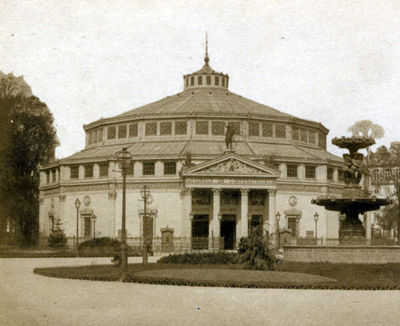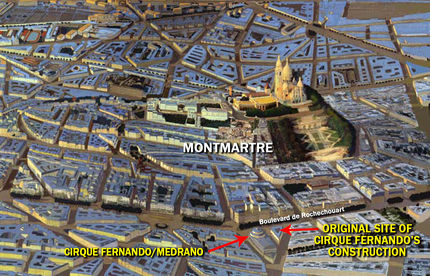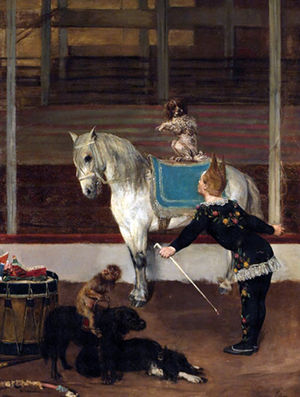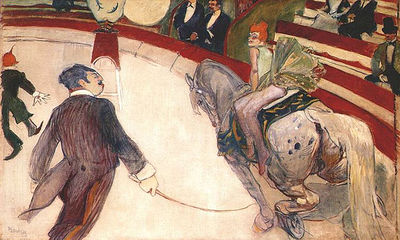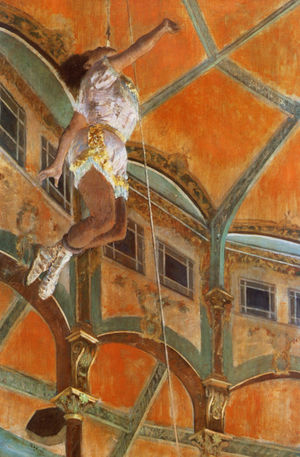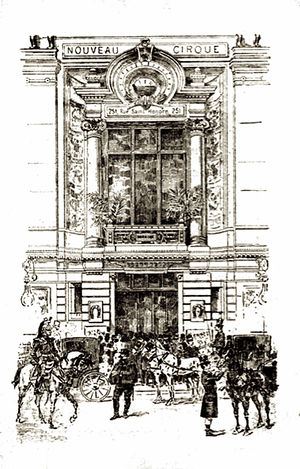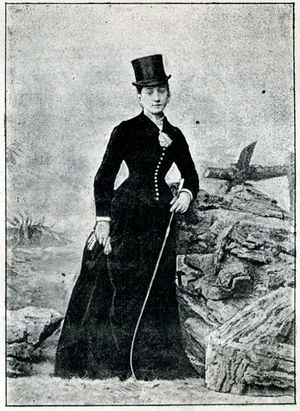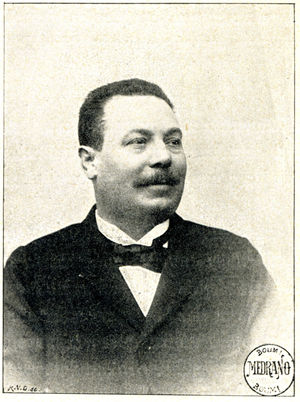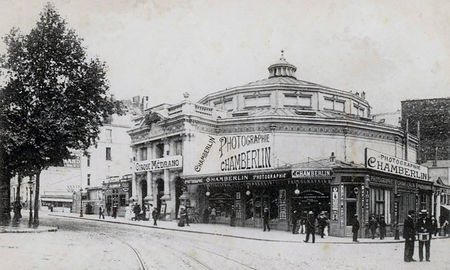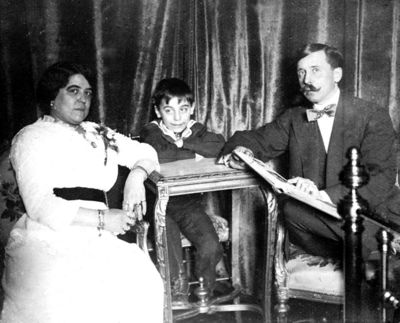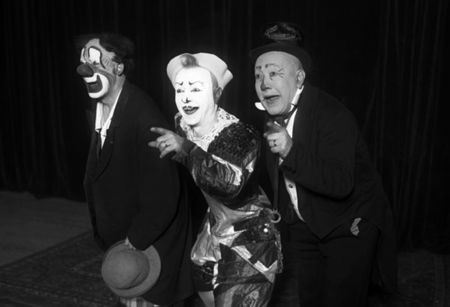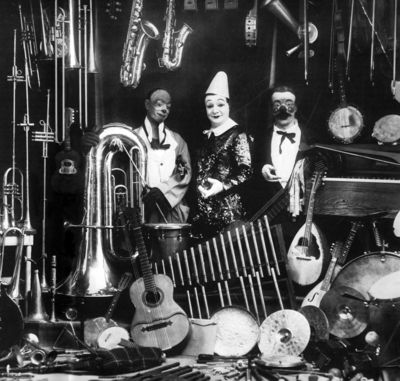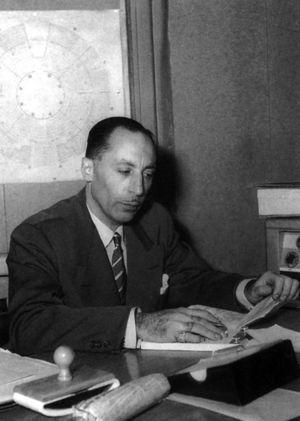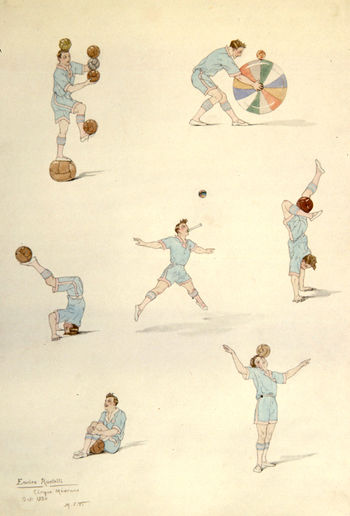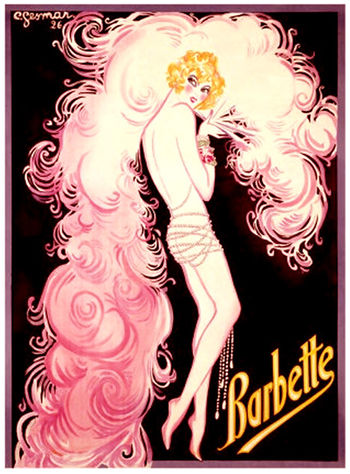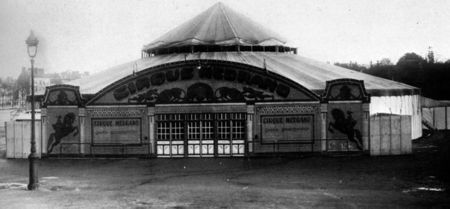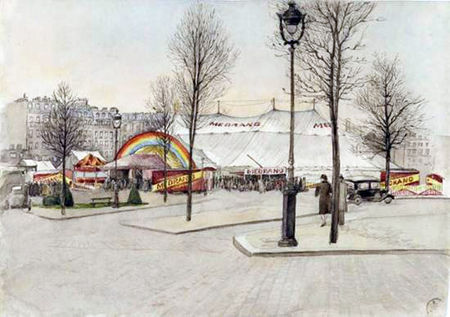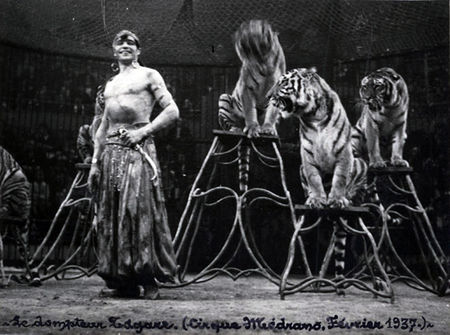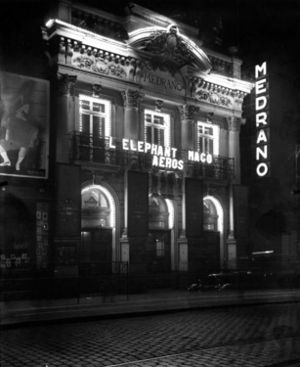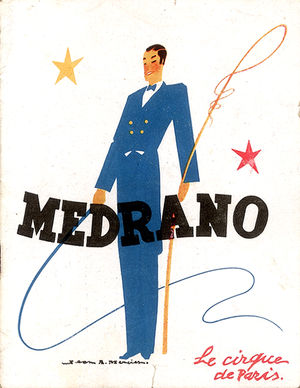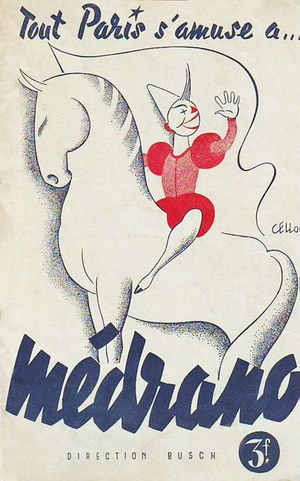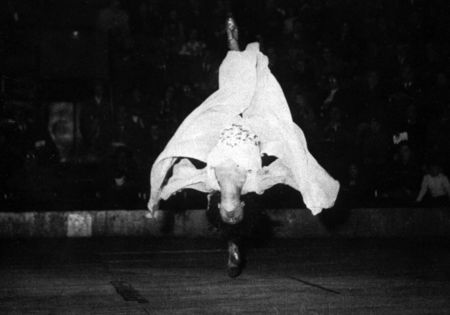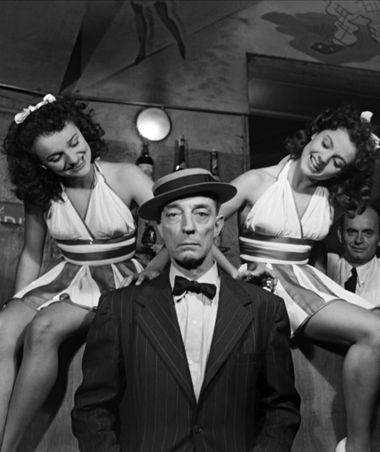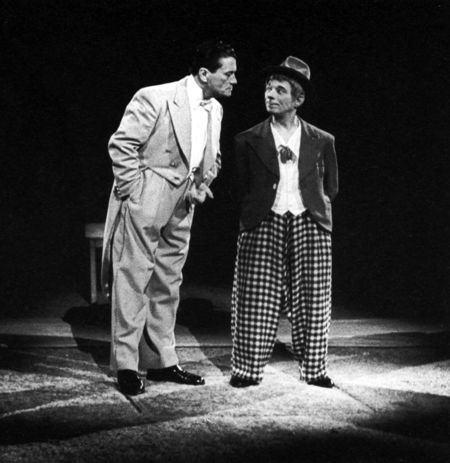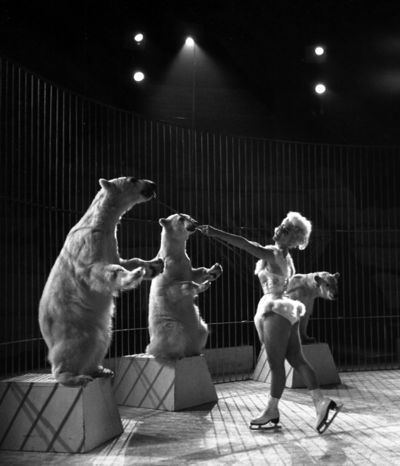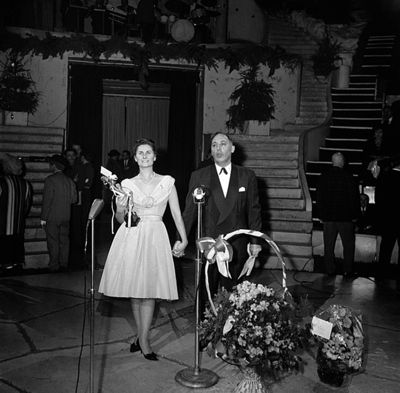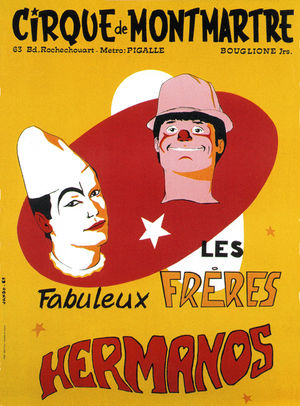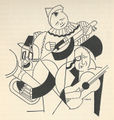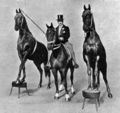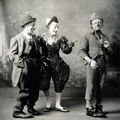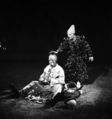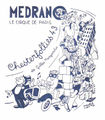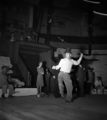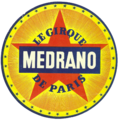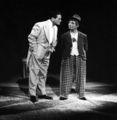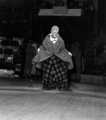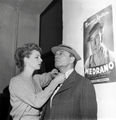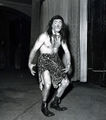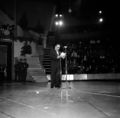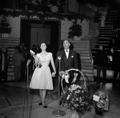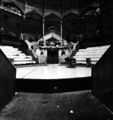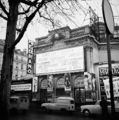Difference between revisions of "Cirque Medrano (Paris)"
From Circopedia
| Line 5: | Line 5: | ||
Sometimes referred to as "The Temple of Clowns," it has featured many of the world’s greatest clowns, from Geronimo Medrano to [[Buster Keaton]], and launched the extraordinary career of the [[Les Fratellini|Fratellinis]]. It had also sent into the limelight hitherto little known performers of immense talent, transforming them into genuine circus stars; appearing in its ring was a recognition for any circus artist. Its last performance under Jérôme Medrano’s reign in January 1963 was an event attended by the Tout-Paris of the arts, and its demolition in December 1973 caused a massive uproar that eventually led to a legislation protecting Paris’s historic theaters. | Sometimes referred to as "The Temple of Clowns," it has featured many of the world’s greatest clowns, from Geronimo Medrano to [[Buster Keaton]], and launched the extraordinary career of the [[Les Fratellini|Fratellinis]]. It had also sent into the limelight hitherto little known performers of immense talent, transforming them into genuine circus stars; appearing in its ring was a recognition for any circus artist. Its last performance under Jérôme Medrano’s reign in January 1963 was an event attended by the Tout-Paris of the arts, and its demolition in December 1973 caused a massive uproar that eventually led to a legislation protecting Paris’s historic theaters. | ||
| − | |||
| + | |||
| + | [[File:Medrano_Farandole.jpg|right|300px]] | ||
===Ferdinand Beert=== | ===Ferdinand Beert=== | ||
Revision as of 20:26, 30 July 2023
By Dominique Jando
Paris’s legendary Cirque Medrano holds a singular place in the Parisian cultural fabric(See: Tissu) and in circus history. From its beginnings as Cirque Fernando, in 1873, until the end of Jérôme Medrano’s management in 1962, it was tightly woven into the artistic life of the French capital, not only as a popular place of entertainment, but also for its long association with artists, writers, journalists, and Paris’s intelligentsia in general. It has been celebrated in paintings, novels, movies, and even popular songs. Its history is also closely intertwined with the life of its three historic directors: Louis Fernando, Geronimo Medrano, and Jérôme Medrano.
Sometimes referred to as "The Temple of Clowns," it has featured many of the world’s greatest clowns, from Geronimo Medrano to Buster Keaton, and launched the extraordinary career of the Fratellinis. It had also sent into the limelight hitherto little known performers of immense talent, transforming them into genuine circus stars; appearing in its ring was a recognition for any circus artist. Its last performance under Jérôme Medrano’s reign in January 1963 was an event attended by the Tout-Paris of the arts, and its demolition in December 1973 caused a massive uproar that eventually led to a legislation protecting Paris’s historic theaters.
Contents
- 1 Ferdinand Beert
- 2 LE CIRQUE FERNANDO (1875-1897)
- 3 LE CIRQUE MEDRANO (1897-1962)
- 3.1 "Boum-Boum" Medrano, Circus Director
- 3.2 Change Of Guard
- 3.3 Berthe Medrano’s Circus
- 3.4 The Bonten Era
- 3.5 Enter Jérôme Medrano
- 3.6 Medrano’s Golden Age
- 3.7 Innovations And Expansion
- 3.8 Medrano Voyageur
- 3.9 Before The Storm
- 3.10 The War Years
- 3.11 The Post-War Era: The Floor Show
- 3.12 To America And Back
- 3.13 The Early Fifties
- 3.14 The Survival Years
- 3.15 Swan Song
- 3.16 The End
- 4 Epilogue
- 5 Suggested Reading
- 6 See Also
- 7 Image Gallery
Ferdinand Beert
This most Parisian of circuses was actually built by a Belgian circus entrepreneur. Ferdinand Constantin Beert (1835-1902) was born July 31, 1835 in Courtrai, Belgium, to Auguste Jean Beert, a butcher, and Delphine Beert, née Steinbrouk. As legend has it, at age eleven Ferdinand "ran away and joined the circus"—in this case the Cirque Gauthiez, which was touring in Belgium. There, as the story goes, Ferdinand trained with an acrobat and worked as a groom, learning the basics of horsemanship on the job. Yet, how Ferdinand’s career actually evolved after his auspicious flight from home remains conjectural, but he did actually work for Gauthiez.
On April 17, 1857, Ferdinand Beert married in Bruges Maria Theresia De Seck, a Belgian equestrienneA female equestrian, or horse trainer, horse presenter, or acrobat on horseback. who, like him, was not born in the circus: Her father, Pieter, was a bargeman. Ferdinand was twenty-two; Maria Theresia already had a son, Ludovicus Carolus (Louis Charles), born in Bruges on July 26, 1851, probably out of wedlock, whom Ferdinand adopted. Louis-Charles (the future Louis Fernando, 1851-1917) was then six years old, just fifteen years younger than his new stepfather. The Beerts toured with the Cirque Gauthier in Belgium, Holland, Germany, and England. During this time, Louis was being trained as an equestrian—against his will, it must be said.
In 1861, Ferdinand Beert was hired by Louis Dejean (1786-1879), the famous French circus entrepreneur, for his Parisian resident company. Beert performed for the first time in the French capital at Dejean’s Cirque Napoléon (today’s Cirque d’Hiver), and then, for the summer season, at his Cirque de l’Impératrice on the Champs-Elysées. For his first appearance with Dejean, Ferdinand presented an acrobatic duet on horseback with his partner, Armand, and performed a barrel-vaulting act. Ferdinand Beert, who was a very versatile all-around performer, remained with Dejean for ten consecutive years, appearing in a wide variety of acts, on horseback and on the ground, as well as in clown entrées and in pantomimes.In time, Louis Beert would perform the same equestrian repertoire as his father’s, but after a bad fall in 1865 in which he suffered a broken leg and a broken arm, Louis was forced to abandon bareback riding. The great Equestrian Master François Baucher (1796-1873), who was Dejean’s equestrian director, decided to take Louis under his wing and teach him the intricacies of true horsemanship—from classic haute-école(French) A display of equestrian dressage by a rider mounting a horse and leading it into classic moves and steps. (See also: High School) to presentation of horses "at liberty"Liberty act", "Horses at liberty": Unmounted horses presented from the center of the ring by an equestrian directing his charges with his voice, body movements, and signals from a ''chambrière'' (French), or long whip.." Their sedentary years in Paris also gave Ferdinand and Maria-Tereza Beert the possibility to give Louis a solid academic education.
While working for Dejean, Ferdinand acquired a stage name, Fernando, and most importantly, a good knowledge of the Parisian audience. He had had also ample opportunity to observe at close range how Dejean managed his circuses. In the summer of 1871, Fernando appeared for the last time at the Cirque des Champs-Élysées—the Cirque de l’Impératrice’s new name after the fall of Napoléon III’s Second Empire in 1870. He would not return to the newly named Cirque National (formerly Cirque Napoléon) for the winter season: Contemplating the dawn of a new Republican era, Fernando Beert had decided to start his own circus!
LE CIRQUE FERNANDO (1875-1897)
Beert’s original Cirque Fernando, a traveling circus, was launched at Vierzon, a small town in France’s Center region, in the spring of 1872. The company included ten horses and five artists: Fernando and his stepson, Louis (now twenty-one), the equestrian Philippe Bertoletti, the trapeze artist and equestrian Baptiste Gillardoni, and the English clown George Howard. It was a small company, but the number of horses and the presence of four equestrians reveal that horsemanship was the performance’s main fare—not surprisingly, since the age of equestrian circus was still in full bloom.
Fernando’s roster of performers grew in number as his circus toured the French provinces with various degrees of success. As for Maria Theresia, now known as Marie-Thérèse, she had retired from performing and took care of the administration (i.e. box office and basic accounting); she was also quite busy bringing up the couple’s three children, Adolphe, Marthe, and Eugénie—of whom only Adolphe and Marthe would perform in the family’s circus—and she had perhaps lost the slender physical shape expected of a ballerina on horseback. She was now the respectable Mrs. Fernando.
La Fête de Montmartre
In August of 1873, Fernando set up his circus tent at the Fête de Montmartre, a popular summer fair that was traditionally held on the hill of Montmartre, on the northern edge of Paris. The previous month, however, the French government had given the green light to the construction(French) A temporary circus building, originally made of wood and canvas, and later, of steel elements supporting a canvas top and wooden wall. Also known as a "semi-construction." of the Sacré-Cœur basilica on the open space where the fair traditionally took place, at the top of the hill. Consequently, the fair was moved down to the median walkway of the Boulevard de Rochechouart, on the southern edge of Montmartre. It was large enough to accommodate the fair’s booths and carousels, and even a traveling menagerie, but not a circus tent. Luckily, Fernando found an empty lot at the corner of the Boulevard de Rochechouart and the Rue Lallier, and was able to lease it for the duration.
Montmartre and its immediate vicinity formed a animated and colorful working-class neighborhood, already renowned for its many places of amusement: La Boule Noire, one of its better known dancing halls, was located just across the boulevard from Fernando’s lot; there were also the Bal Tabarin and La Reine Blanche, to mention just two of the most famous "bals" (dancing halls) that attracted revelers to the Boulevard de Rochechouart. The Moulin de la Galette, a "guinguette" (a tavern with dancing), was another popular rendezvous located on the hill itself; and soon, the Bal du Moulin Rouge would be added to the list (on the Boulevard de Clichy, the western continuation of the Boulevard de Rochechouart).Montmartre’s large bohemian population included many painters—among whom Auguste Renoir, Edgar Degas, Georges Seurat, and Henri de Toulouse-Lautrec. They quickly became regulars of the Cirque Fernando, where Mrs. Fernando gave them free access to rehearsals to sketch the performers at work and, sometimes, to see the show. In turn, they brought in their wake a host of young trendsetting writers, journalists and other Parisian literati to the circus; these well-connected visitors would generate a considerable publicity for the Fernandos.
When it was originally set up in Montmartre, Fernando’s circus was a small canvas tent supported by a single pole, which offered rather spartan seating accommodations; with its worn wooden wagons surrounding the tent, and most of its artists living onsite, the whole affair looked like a gypsy encampment. Yet, Fernando’s show was commendable and had charm, and it was generally well received by the critics who made the trip to the Boulevard de Rochechouart.
More importantly, Fernando discovered that there was a large indigenous population ready to return to a local circus when its programs were renewed—to which could be added the many visitors who came to have a good time in this lively neighborhood. Thus, when the fair came to an end, Fernando extended his lease and replaced his tent by a semi-construction(French) A temporary circus building, originally made of wood and canvas, and later, of steel elements supporting a canvas top and wooden wall. Also known as a "semi-construction." with a canvas top over a wooden structure, and a boarded wall to keep it warm during the coming winter months.
The French novelist Jules Claretie (1840-1913) gave a good description of the Cirque Fernando at that time in his novel Le Train 17 (1877), in which his not-so-imaginary circus was named Cirque Francis Elton: "It was not a luxurious circus with seats covered with velours; it was nearly a traveling circus, and its rotunda, covered with canvas, grown, somehow, in the middle of Paris, suddenly, like some vegetation after the rain, had quite surprised the population of the Boulevard de Clichy..." Even though Claretie's story is indeed fictional, its setting and its main character, Francis Elton, are based on the Cirque Fernando of that period and its director, Ferdinand Beert.
By then, Fernando’s company of performers had expanded; in the spring of 1874, it included—beside the Fernandos, Bertoletti and Gillardoni—Ferdinand and Victor Bouthors; the equestriennes Clotilde Bertoletti, Mlle Marthe (Fernando) and Mlle Juliette; and most significantly, the clown Geronimo Medrano (1849-1912) and his partner, Pasquale. Unbeknownst to him, Medrano was on his way to stardom in a building that would one day bear his name—for Mrs. Fernando, who saw the money flowing in at the box office, had decided it was time to build a permanent circus in Montmartre.
The Circus That Fernando Built
At the beginning of 1874, the Fernandos had met with a Mr. Loiseau, owner of the ground where they were installed, and since Loiseau had no immediate prospect for his piece of land, they secured a thirty-year lease on a parcel located a few yards west of their construction(French) A temporary circus building, originally made of wood and canvas, and later, of steel elements supporting a canvas top and wooden wall. Also known as a "semi-construction.", at the corner of the Rue des Martyrs. Unlike the Rue Lallier, the Rue des Martyrs intersected the Boulevard de Rochechouart at a right angle, which made the design of a building easier. Furthermore, they could keep their existing circus structure active on its old spot during the construction(French) A temporary circus building, originally made of wood and canvas, and later, of steel elements supporting a canvas top and wooden wall. Also known as a "semi-construction." work.
Some circus historians have mentioned that no building permit has ever surfaced, thus inferring that the construction(French) A temporary circus building, originally made of wood and canvas, and later, of steel elements supporting a canvas top and wooden wall. Also known as a "semi-construction." of the Cirque Fernando had been somewhat illegal. However, this is a misconception: There were no building permits per se at the time, and the documents presented to the Prefecture de Police constituted in themselves the "permis de bâtir"—unless the Préfecture de Police opposed the construction(French) A temporary circus building, originally made of wood and canvas, and later, of steel elements supporting a canvas top and wooden wall. Also known as a "semi-construction." of a building on the planned location for a reason or another, but not related to any technical or architectural aspect of the construction(French) A temporary circus building, originally made of wood and canvas, and later, of steel elements supporting a canvas top and wooden wall. Also known as a "semi-construction.". It was just a routine procedure. Since nothing prevented the construction(French) A temporary circus building, originally made of wood and canvas, and later, of steel elements supporting a canvas top and wooden wall. Also known as a "semi-construction." of a circus on Fernando's chosen location, the work began on August 15, 1874.
To finance part of the operation, the Fernandos made an unusual deal with their building contractor, a Mr. Oudin. Oudin agreed to be paid in installments, and as a guarantee, the Fernandos transferred to him all their circus equipment, and even their lease. In turn, Oudin used Fernando’s properties and lease as collateral to obtain a credit of 100,000 francs from the Banque Bouley et Cie. In time, this financial arrangement would generate serious problems, and it would have unintended consequences that eventually resulted in Jérôme Medrano losing his circus to the Bouglione family nearly a century later.
By the end of November, the circus's main infrastructure was completed; the new Cirque Fernando opened its doors seven months later, on June 25, 1875. Its address was at 63 Boulevard de Rochechouart, and it had cost over 500,000 Francs—approximately €5,775,000 today. In spite of a limited space (the usable surface was about 40 x 40 meters) and a relatively small budget, Gridaine had done a very fine job. The style was "classic-Haussmann," with a pleasant façade—albeit missing the equestrian statue that was meant to top it and was never made—ornamented with Corinthian columns framing three arched doors that led to a small reception hall, where the box office was located. Above the doors were the three French windows of the foyer standing above the reception hall, ornamented with elegantly designed wrought-iron balustrades.
The house itself was a sixteen-sided polygon with an inside diameter of 34.10 meters (35 meters outside). The ring had the traditional diameter of 13 meters. The roof, whose metallic frame remained fully visible, was divided in two concentric circles; the inner circle was an elevated cupola, 22.5 meters in diameter, supported by sixteen cast-iron columns. Its height, up to the base of the lantern, was about 20 meters. The peripheral wall of the central cupola had windows, and so had the lantern, so that sunlight could be used during rehearsals and matinees—but there were also sixteen large gas chandeliers hanging between the columns at the circumference of the cupola to lit evening performances.
Unlike the Cirque des Champs-Elysées and the Cirque d’Hiver, the various categories of seats were connected together, which generated a convivial environment. The steep gradient between the rows not only offered the audience an excellent visibility (notwithstanding the columns in front of the Second Places), but also very good acoustics—a definite plus for the clowns. The house was nicely decorated with garlands of flowers painted on the periphery of the cupola, and gold accents adorning architectural details. The columns were painted in faux marble, and the walls and ceiling in a shade of peach-pink. The house irradiated a feeling of warmth and elegance—and intimacy, which was not its lesser charm.
If the house was, of course, circular, the entire building was contained within a square. On the forefront, flanking the façade on each side, were two spaces designed to accommodate a coffee house and offices; starting in 1885, they were leased to the photographic studio Chamberlin, whose name would remain associated with the circus building until the late 1950s. In the back, behind the house, was a small two-story structure; on the street side, next to the stage door (at 72ter Rue des Martyrs), stood the concierge’s lodge and an all-purpose space that could house horses and animals. Fernando’s large apartment was located above, on the second floor.
On the opposite side, stables (with room for 16 horses) occupied the ground floor, and the second floor accommodated a suite of rather cramped dressing rooms for the artists. (Two additional dressing rooms were located below ground level, under the seats, on each side of the ring entrance—one of them traditionally used by the clowns). This side of the building had no door opening outside, since the small Rue Viollet-le-Duc, which would later flank the east side of the circus, didn’t exist yet (it was opened in 1880).
The backstage area, between the two aisles, was relatively narrow; it served nonetheless as a secondary foyer with a small buvette (refreshment stand), which, when the main foyer at the front of the house was later suppressed under Jérôme Medrano’s tenure, was replaced by a bona-fide bar where artists and spectators mingled during intermission—a beloved feature that added to the charm and uniquely convivial atmosphere of this circus.
The Circus That Medrano Also Built
The Cirque Fernando had already begun to develop its Parisian reputation during its canvas days, but now that it was performing in a permanent building, with the added comfort this implied, it quickly became a true destination. Mrs. Fernando continued her policy of giving the neighboring artists free access to rehearsals, and they continued to bring along their friends: Journalists and writers liked the new circus’s warm atmosphere, and Fernando Beert was able to deliver the quality they expected of its shows. They made it known.
Born in Madrid in 1849 to Candido Medrano and his wife Magdalena, née Perez, et, Geronimo trained in gymnastics as an adolescent and, at age twenty, built a flying trapezeAerial act in which an acrobat is propelled from a trapeze to a catcher, or to another trapeze. (See also: Short-distance Flying Trapeze) act with a partner, Leopold Salonne. Created in 1859 at Paris’s Cirque d’Hiver by Jules Léotard (1838-1870), the flying trapezeAerial act in which an acrobat is propelled from a trapeze to a catcher, or to another trapeze. (See also: Short-distance Flying Trapeze) had quickly become an act à la mode—albeit not an easy one to tackle—due to Léotard’s astonishing success. It was originally performed from trapeze to trapeze, but Medrano and Salonne were among the very first flying trapezeAerial act in which an acrobat is propelled from a trapeze to a catcher, or to another trapeze. (See also: Short-distance Flying Trapeze) artists to include passes from a trapeze to a suspended catcherIn an acrobatic or a flying act, the person whose role is to catch acrobats that have been propelled in the air.. Yet what truly set Medrano and Salonne apart is that theirs was a comedy act.
They had already performed all over Europe when they landed in Paris in June 1872, at the Cirque des Champs-Elysées, where they achieved a notable success. Although Fernando had already left Dejean’s company, he may have met Geronimo Medrano then and there. In any event, in 1873, Medrano and Salonne parted company, and Fernando Beert, who had now a circus of his own, offered Medrano to work for him as a clownGeneric term for all clowns and augustes. '''Specific:''' In Europe, the elegant, whiteface character who plays the role of the straight man to the Auguste in a clown team.; Geronimo was blessed with a warm and sunny personality and was immediately successful. He was also good at training small animals, and his favorite partner in the ring was a pig—a foil of choice to many a clown (as Billy Hayden, Tony Grice and, later, Anatoly Durov bear witness).
Quite often, clowns use in the ring a catchphrase that eventually becomes their trademark; Medrano used to give the bandleader the signal to play his exit music by shouting to him a resounding "boum boum!" ("boom boom!") . Geronimo’s recurring exclamation stuck, and very soon his audiences nicknamed him Boum-Boum. Although he was not specifically featured in Fernando’s advertising, a large part of the popular audience went to the Cirque Fernando to see Boum-Boum. He didn’t need to be announced: The audience knew he would be there. He was, so to speak, part of the furniture—and he contributed to a large extent to the Fernando's success.
Enter Louis Fernando
During its first summer recess in August 1875, the Cirque Fernando housed a series of concerts of "modern music." When it reopened in September, Fernando Beert’s stepson, Louis Fernando, was in charge of the programs—becoming in effect the circus’s Artistic Director. Why Fernando delegated this crucial responsibility to Louis? The Beerts were heavily in debt, and to add an extra income, Fernando had decided to resume the tours of his traveling circus, while he progressively left Louis in charge of the building.
Moreover, if Fernando knew how to run a traveling circus, the running of a Parisian circus was another matter altogether: It required to be constantly aware of the performers’ market, endlessly deal with artists or agents, be attuned to the trends of the moment, and most importantly, be very creative. Louis Fernando, who was a snob of sorts eager to be part of Parisian society, had a much better education than his stepfather and kept au courant with the fads of Paris life, and he had indeed a more genial personality. All in all, Louis was better suited than his stepfather to run a Parisian place of entertainment. In fact, Fernando Beert had rarely been in the limelight as a director: His wife and his stepson had always been the circus’s front persons.Louis proved to be a good artistic director; he knew how to compose attractive programs, was open to novelties, and understood well that he had to boost his best property, "Boum-Boum" Medrano. However, on the administrative side, the Beerts’ lack of financial acumen was their Achilles’ heel. In 1876, to satisfy the demands of their creditors, they tried to create a corporation, but the constitution of their capital, as it was, was judged illegal, and the corporation was dissolved. At this point, their financial and legal situation had become so complicated that it had created a vacuum in which Louis Fernando had ample room to move as he saw fit. The flip side was that the Beerts had nothing left to their name: All their properties, including their building and their land lease, were held as a security by their bank.
On January 25, 1876, Louis Fernando married into well-to-do Parisian bourgeoisie: The father of Jeanne Gabrielle Houssaye (1857-1894), his young wife, was a well-known tea merchant who had created the first Parisian tearoom on the Champs-Elysées during the Exposition Universelle (World Fair) of 1867. Louis and Jeanne Fernando took up residence at the Rue du Dôme, near the Place de l’Étoile in Paris, in a fashionable neighborhood. Together, Jeanne and Louis Fernando already had a son, Gabriel Eugène Henry Beert, born September 24, 1875, who had a lackluster career as an acrobat, married in 1900 the daughter of a railways employee, and died in 1902, at age twenty-seven. Over the years, Louis’s lifestyle, fueled by his social ambitions, will hurt his and his circus’s already shaky financial situation.
Nonetheless, Louis Fernando was a capable Artistic Director. He was aware that his circus was not equipped to compete efficiently in the equestrian department with the Cirque d’Hiver and the Cirque des Champs-Elysées, or to stage the spectacular pantomimes the Cirque d’Hiver, and soon, the huge Hippodrome de l’Alma (open in 1877) produced. The Cirque Fernando was, however, better tailored than its competition for intimate comedy, and it had a popular leading clown to boot. In January 1876, Louis produced Le Barbier Frétillant ("The Wriggling Barber"), a comic pantomimeA circus play, not necessarily mute, with a dramatic story-line (a regular feature in 18th and 19th century circus performances). with Boum-Boum in the title role. It was the first of a long series of similar pieces that featured Geronimo Medrano and made him a true circus star.Novelty acts, not star equestrians, were what set the Cirque Fernando apart—from an all-female equestrian show, to the riding seal of Raziscoff, or the lions of Captain Cardona. In December 1878, the sensation of the show was the Mulatto aerialistAny acrobat working above the ring on an aerial equipment such as trapeze, Roman Rings, Spanish web, etc. Miss Lala (Olga Albertina Brown, 1858-?), "la Sirène des Tropiques" ("The Tropics’ Mermaid"), who had a considerable Parisian success and was immortalized by Edgar Degas. (This show also featured the Fratellinis, in the person of Gustave Fratellini—the father of the legendary François, Paul and Albert—and his partner Gustave Romoli.) Miss Lala and the Kaira Troupe (in which she belonged) went on tour with the tenting Cirque Fernando during the summer and remained under contract with Fernando until the end of 1879.
When the Cirque Fernando went on its annual provincial tour under canvas in the summer of 1879, Medrano went to work at the Hippodrome de l’Alma, while the Fernando building was rented out and transformed into a café concert—a variety show featuring mostly singers, and where drinks were served. The circus would often be similarly rented out in the summer for extra-curricular activities, and during the season, on dark days, for public meetings or political reunions: The most publicized of them were meetings held by Georges Clémenceau, then the Député (M.P., or Representative) of Montmartre. (A major French columnist and politician, Clémenceau would become France’s Prime Minister in 1917, during WWI, and helped build victory over Germany.)
Geronimo Medrano was still Fernando’s top attraction(Russian) A circus act that can occupy up to the entire second half of a circus performance., and the central character of its joyous pantomimes. At the opening of the 1882 season, he was additionally promoted to the important function of Régisseur Général—a mixture of company manager and performance director specific to the circus: He was in charge of the performers, the crew, the rehearsals, and the performances. In his spare time, he also trained young equestriennes, such as the Cardinale Sisters, who performed at the circus as bareback riders in 1885.
As for Jeanne Fernando, Louis’s wife, she had made her debut in 1881 as an haute-école(French) A display of equestrian dressage by a rider mounting a horse and leading it into classic moves and steps. (See also: High School) rider at the fashionable Cirque d’Amateurs that Ernest Molier presented annually in his Parisian townhouse on the rue de Bénouville, the courtyard of which had been converted into a small private circus. She had been trained in horsemanship by her husband, according to Baucher's method, and had become a remarkable equestrienneA female equestrian, or horse trainer, horse presenter, or acrobat on horseback.. "Madame Louis Fernando" was subsequently an intermittent equestrian feature of her husband’s circus: She was not in good health, which often took her away from the ring for long periods of time.
Competition
On February 12, 1886, Joseph Oller’s brand-new Nouveau Cirque opened its doors on Rue Saint-Honoré, in the prosperous center of Paris, at a stone-throw of the Place Vendôme. It was a revolutionary circus: Its ring could sink to reveal a water basin—the very first circus equipped with such a device. It had also a palatial and comfortable house (with individual theater seating) which had been designed by Fernando’s architect, Gustave Gridaine. However, the façade and the elaborate reception hall were the work of Charles Garnier (1825-1898), the celebrated architect of Paris’s extravagant Opéra, which gave the place an additional cachet.Beside its plush elegance and its chic surroundings, which would quickly make it the High Society’s circus of choice, the Nouveau Cirque had put together a brilliant company of artists, among which was a group of very talented clowns: George Foottit, Alexandre Pierantoni, and Tony Grice with his young apprentice, the Black augusteIn a classic European clown team, the comic, red-nosed character, as opposed to the elegant, whiteface Clown. Chocolat. The Nouveau Cirque also made good use of its water basin with comic pantomimes that inevitably ended with a big splash in the pool! Novelties and comedy had been so far what had distinguished the Cirque Fernando from Franconi’s more horse-oriented Cirque d’Hiver; now, Fernando had serious competition in its own particular domain from a better-located, and somehow more attractive circus.
Louis Fernando’s business remained good nonetheless, as he stuck to the recipes that had made his success. Although George Foottit, already a star clownGeneric term for all clowns and augustes. '''Specific:''' In Europe, the elegant, whiteface character who plays the role of the straight man to the Auguste in a clown team., loomed bigger than Medrano in the public eye, Boum-Boum was still attracting a faithful audience to the Boulevard de Rochechouart. Then, at the end of the summer of 1887, the touring Cirque Fernando ceased its activity (Fernando Beert probably retired soon after that). In 1888, the circus on the Boulevard de Rochechouart remained open during the summer three days a week; the rest of the time, Louis Fernando gave riding and vaulting lessons in the ring. Times were changing—and not for the better…
In January 1889, the Cirque Fernando offered En Selle pour la Revue, a humorous revue of the previous year’s events—the original meaning of a revue, a fashionable theatrical form then—written for "Boum-Boum" Medrano at his request by two well-known librettists, Surtac and Alévy (Gabriel Astruc, 1864-1938, and Armand Lévy, 1859-1935). Boum-Boum was the revue’s traditional compère (a mixture of Master of Ceremonies and stand-up comedian), and Louis Fernando, playing himself, was his straight man. It was a huge success that remained on the bill for three months, in spite of the controversial presence in the cast of La Goulue (Louise Weber, 1866-1929), the infamous Cancan dancer immortalized by Toulouse-Lautrec.
Yet, on the Boulevard de Rochechouart, all was not in the pink at the "pink circus" (as the circus chronicler Serge would later dub it, referring to its warm color scheme, of which he was particularly fond). Louis Fernando’s financial situation was becoming increasingly unmanageable. As much as he was attached to the circus that had made him famous, Medrano was, from his position as Régisseur Général, well aware of Fernando’s troubles, and he couldn’t see a bright future for himself in his company; in May, at the end of the season, Geronimo Medrano left the Cirque Fernando. In August, Boum-Boum debuted at the Nouveau Cirque, rue Saint-Honoré.
Fernando’s Decline
With Medrano’s defection, Fernando had indeed lost one of its main drawing cards. Although Boum-Boum Medrano did well as a clown at the Nouveau Cirque, he was outshined by George Foottit, who began to team up regularly with the Black augusteIn a classic European clown team, the comic, red-nosed character, as opposed to the elegant, whiteface Clown. Chocolat; together, Foottit & Chocolat will become the Toasts of Paris, and remain so for a full decade. But Medrano had made a good move: In 1892, Raoul Donval, the Nouveau Cirque’s new director, who appreciated Geronimo’s many talents, gave him the position of Régisseur Général—the same position he had held for Louis Fernando, but this time in a much healthier financial environment.
As for Louis Fernando, he had a huge success the same year with his politico-military pantomimeA circus play, not necessarily mute, with a dramatic story-line (a regular feature in 18th and 19th century circus performances)., Les Marins de Cronstadt, but he flopped soon after with a comic pantomimeA circus play, not necessarily mute, with a dramatic story-line (a regular feature in 18th and 19th century circus performances)., Robert Macaire, which he kept nonetheless on the bill for two months—which suggests that he had nothing else to offer. Nonetheless, Fernando’s programs remained by and large attractive, with their usual mix of novelty acts and comic pantomimes, which still competed effectively with the traditional equestrian fare of the Franconis’ Parisian circuses.
To make matters worse, Jeanne Fernando died on May 8, 1894 from a "terrible disease," which may have been tuberculosis—for which there was no cure at the time, and the frightening name of which, like cancer, was always hushed up. Jeanne was only thirty-six, and Louis Fernando was devastated. He closed his circus and rented the building out for a season of operettas; the circus took the name of Théâtre Parisien. It finally reopened as a bona-fide circus in December with the Troupe Rancy-Loyal in a show originally produced by Alphonse Rancy in his resident circus at Lyon. Louis Fernando was nowhere to be seen.
The Rancy-Loyal Troupe occupied the Cirque Fernando, renewing its shows regularly, until the spring of 1895. Then the circus was again rented out for a summer season of variety, and took the name of Concert d’Été. Finally, at the end of the summer, it was completely refurbished, equipped with theater seating and a coco mat in the ring, as in the Nouveau Cirque, and reopened at last in September 1895 under Louis Fernando’s management. In spite of commendable programs that were renewed each Wednesday, Louis Fernando had a hard time trying to bring back his public; he even had to lower his price of admission.
By then, the Banque Boulley et Cie, his bank, had long realized the security they had inherited from the Fernandos’ original dealings. On October 25, 1897, the new owner of Fernando’s circus building, who obviously had not been paid by his tenant, announced that the entire property, land and walls, would be auctioned off: His tenant, Louis Fernando, had staged a moonlight flit. The press mentioned the upcoming sale in early November. What exactly happened after that point is unknown; the sale, if any, was not publicly reported. In any event, the circus was closed and left with a sign on its door: "For Rent."
It was much later discovered that Louis Fernando had remarried, with Marie Vennekens, on October 3, 1897 in Courbevoie, a Paris suburb, a short time before the announcement of his circus’s sale; after her death, he married a third time, on October 28, 1900, with Estelle Ganthey. Louis Fernando then disappeared from the public eye—and from the circus scene. No one noted his death in Paris on February 26, 1917; he had lived at the time rue Danrémont, not far from Montnartre. The Fernando-Beert tomb at the Cimetière de Montmartre mentions only his wife, Jeanne, and their son, Gabriel. His mother and stepfather had long retired to Bruges, Belgium, where Fernando Beert passed away on December 30, 1902.
Thus, by November 1897, the saga of the fabled Cirque Fernando had finally come to an end. Or had it?
LE CIRQUE MEDRANO (1897-1962)
Geronimo Medrano, like everyone else in the circus world, had followed the disturbing disintegration of the Cirque Fernando—but to him, the announcement of its demise hit closer to home. He had spent fifteen years with Fernando, saw the circus building come up, and he became famous in its ring; aside from Louis Fernando, no one had had more to do with its success than Medrano. For seven years, as its Régisseur Général, he had also managed its daily operations. He knew this circus inside out. Geronimo Medrano had just managed Raoul Donval’s short-lived Hippodrome du Champs de Mars (1894-1897), on the Avenue Rapp; he was approaching his fifties, and he thought it was perhaps time to move ahead…
"Boum-Boum" Medrano, Circus Director
All of a sudden, in December 1897, it was announced that Geronimo Medrano was the new tenant of the circus on the Boulevard de Rochechouart, which he had renamed Cirque Medrano. Medrano, well aware that time was of the essence if he wanted to take hold of the vacant Cirque Fernando, had moved swiftly. In order to secure a long-term lease (the annual rental price was 40,000 Francs, about €128,000 today), he had enrolled his old friend Emilio Maîtrejean, a retired acrobat and daredevil (and the son of the former Régisseur of the Cirque Napoléon), who had put his savings at Geronimo’s disposal.
Financially the operation could have been risky, as the Fernandos’ misadventures had shown all too well, especially since Medrano didn’t have time to secure any other backing source. However, two factors had swayed his decision: Firstly, the Cirque des Champs-Elysées was moribund and the Cirque d’Hiver was declining, which limited serious competition to the Nouveau-Cirque; more consequential, Chamberlin, the photo studio that occupied the spaces framing the circus’s façade, was the tenant of the circus itself, not of the property’s owner, and Medrano would therefore collect Chamberlin’s rent—the amount of which was about 40,000 Francs a year.… Geronimo signed a deal with the proprietor without much vacillation and moved his quarters into the circus building’s apartment!The press had been glad to spread the good news, enthusiastically wishing success to the new director. Unlike Louis Fernando, whom they had often derided as a snob and a social climber, the happy, genial, outgoing "Boum-Boum" Medrano had an excellent reputation among Parisian journalists and critics, and of course among the old Cirque Fernando’s aficionados. The fact that the defunct Cirque Fernando was now Medrano’s circus seemed to everybody a logical conclusion. And as everybody knew, a circus that bore the name of Medrano could only be a joyous circus.
Thus the Cirque Medrano opened its doors on December 22, 1897 to an enthusiastic audience—neighborhood habitués and the usual crowd of Parisian cognoscenti, journalists, and artists of all species. The General Manager was Emilio Maîtrejean, and the company for the season included the Fratellinis—that is to say, the remarkable somersaulter on horseback François Fratellini, his brothers, the clowns Luigi and Paolo (Louis and Paul), and The Gentlemen, the eccentric acrobatic and musical act performed by Albert and François. Not yet the fabled clown trio (which would form after Louis’s death in 1909), the Fratellini brothers had nonetheless sowed the seeds of a long association with the Cirque Medrano.
There were other clowns in the program, notably Alexandre Pierantoni, formerly of the Nouveau Cirque, "and his augusteIn a classic European clown team, the comic, red-nosed character, as opposed to the elegant, whiteface Clown.", and comic pantomimes would often be part of the fare—the first of which was titled Le barbier fin-de-siècle ("The End-of-Century Barber"). Geronimo Medrano, however, was not performing as a clown anymore: He was now a Circus Director, and would only appear sporadically holding the chambrière(French) Long whip customarily used by Equestrians for the presentation of horses "at liberty." (the Equestrian Master’s long whip), but the show bore his distinctive, joyful stamp. Like its predecessor, the Cirque Medrano gave priority to novelty acts and comedy, and it changed its program partially every week, with performances every night, and matinees on Thursdays, Saturdays, Sundays, and Holidays.
Geronimo Medrano maintained the old open-door policy that Mrs. Fernando had originated for the neighboring artists. The establishment of the legendary Bateau-Lavoir as an artists’ communal house in Montmartre at the turn of the century would bring another generation of upcoming artists and painters to the Cirque Medrano: Pablo Picasso, Juan Gris, Georges Braque, Henri Matisse, Kees van Dongen, Jean Cocteau, Guillaume Apollinaire, to name but a few. Like their predecessors, they helped keep in the limelight the already fabled "cirque montmartrois" (circus of Montmartre).
Unlike the ambitious and carefree Fernando, Medrano was fiscally conservative. He also knew how to attract good acts at a reasonable price: He was well known and had a good reputation in the business, and his cheerful personality was hard to resist. The circus had shown a positive balance sheet at the end of 1898. In 1899, its gross income had increased by 123,534 Francs. After Fernando’s never-ending financial quandaries, Medrano’s landlord was finally able to put his mind at rest. Meanwhile, that same year, Charles Franconi closed the venerable Cirque des Champs-Elysées, which had once been Paris’s most fashionable circus.A new Hippodrome opened its doors in May 1900 on the Place de Clichy, not very far from Medrano. It was supposed to take advantage of Paris’s Exposition Universelle (World Fair) of 1900, but the Fair didn’t prove a boon for Parisian circuses. A huge arena designed for equestrian spectaculars, the Hippodrome was perhaps too big to be profitable: it would eventually close in 1907. (It was transformed into Europe’s largest movie house, the Gaumont Palace—the Parisian equivalent of New York’s Radio City Music-Hall.) In 1906, another circus was built on Paris’s Left Bank, Avenue de la Motte-Piquet, the cavernous Cirque Métropole, which would also suffer from its sheer size, but would remain active with various ups and downs until 1930. And there were still, of course, the Cirque d’Hiver and the Nouveau Cirque.
Paris had become, and would remain until the 1950s, Europe’s circus capital. In spite of heavy competition, the Cirque Medrano held its own without a flinch, and whereas all its competition would have dark interludes and turn into movie houses or theatres at times, Medrano never ceased being a circus. It had qualities that its rivals couldn’t truly match: Its warmth and intimacy, a lack of pretension that reflected well the personality of its beloved founder, a great variety of offerings, clowns who were allowed to shine in an environment that perfectly suited them, and perhaps for all these reasons, it had fierce supporters. Soon, the circus on the Boulevard de Rochechouart became known simply as "Medrano": Parisians used to "go to Medrano"—a household name that had grown to be synonymous with Circus and didn’t need qualifiers.
Change Of Guard
On July 5, 1892, while he was still working at the Nouveau Cirque, Geronimo Medrano had married Charlotte Blanche Lippold (1854-1905). They formed a strong couple, even though Blanche was barren and didn’t give Geronimo an heir. On August 18, 1905, at age fifty-one, Blanche Medrano passed away, rather suddenly; Geronimo was devastated. He was fifty-six years old (at a time when the average life expectancy for men was around fifty years), he had no successors, and he felt his life had suddenly become pointless. Yet he had a solid support system in his close friends at the circus: The faithful Emilio Maîtrejean, Thomas Hassan, his Régisseur, and "Mr. Emile" (Émile Laurent) his comptroller. They helped him go through a very difficult period.
His circumstances brightened up in early 1906, when Geronimo found a warmhearted confidante in Berthe Perrin (1876-1920), a thirty years old seamstress who was twenty-five years his junior. Their friendship eventually developed into an affair and, on May 18, 1907, Berthe gave birth to a son, Jérôme (1907-1998). The Medrano line was finally revived, and Geronimo was elated. He married Berthe on August 28, and legitimized his son on the occasion. By all accounts, Berthe was a sweet, caring person, but her humble origins and hard life had made her a strong woman who knew how to take care of business. Although she was not a circus person, Berthe Medrano proved to be a good partner to Geronimo.In 1908, Medrano hired a new clown duet, Antonet & Grock. Grock had replaced Antonet’s previous partner, the celebrated and immensely creative Little Walter, whose appearance Grock had copied to perform the musical entrée(French) Clown piece with a dramatic structure, generally in the form of a short story or scene. Walter had created with Antonet. The piece, with some additions and much stretching, will make Grock a star. The following year, Louis Fratellini died in Warsaw from a smallpox epidemic, and his brothers, François, Paul and Albert joined forces and formed a clown trio to help support Louis’s widow and large brood. Although these two names, Grock and Fratellini, will long be associated with Medrano, the circus’s stars were then the talented and popular Spanish clowns Rico and Alex Briatore, who were featured on the Boulevard de Rochechouart from 1910 to 1914.
As Parisians’ favorite clowns, Rico & Alex had successfully supplanted the Nouveau Cirque’s Foottit & Chocolat, whose association was coming to an end. As a matter of fact, Medrano was now the Parisians’ circus of choice. The Cirque d’Hiver had been converted into one of Paris’s worst movie houses in 1907; this was followed for a few months, at the beginning of 1908, by the Cirque Métropole, although it quickly re-opened as a bona-fide circus under a new management (and a new name: Cirque de Paris). As for the Nouveau Cirque, it had begun its long decline. Medrano had dealt smartly with the emerging success of the cinematograph: From 1912 until the end of World War I, its programs ended with a short projection of the "American Vitograph" (sic)—which morphed into the "Medranograph." Other acknowledgement of changing times: Geronimo had installed electric lighting.
Although everything was looking good for his circus, it was not the same for Geronimo Medrano. Sometime in late 1910, he had a stroke that left him partially paralyzed. Nonetheless, he bravely continued running his circus until April 27, 1912, when he died suddenly of an attack of uremia; he was sixty-two, and his son, Jérôme, who sadly had had very little time to know his father, was only five years old. Geronimo had bequeathed the Cirque Medrano to him.
Berthe Medrano’s Circus
Geronimo "Boum-Boum" Medrano was inhumed near his first wife, Blanche, after whose death he had commissioned a mausoleum at the nearby Cimetière de Montmartre. A large crowd accompanied him to his last resting place. As for Berthe Medrano, she was intent on preserving their son’s inheritance; without hesitation, she took over the management of the circus that bore her and her son’s name. She left to her late husband’s associates, Emilio Maîtrejean and Thomas Hassan, the care of running the circus’s day-to-day operation, and asked a former acrobat whom she trusted, Rodolphe Bonten (1869-?), to help her cast the shows. As for the circus’s finances, she took full control. To make things clear, five-year-old Jérôme Medrano, dressed in the traditional blue uniform of the régisseurs, appeared at the ring entrance at some matinees.Berthe Medrano proved a good administrator, and the team that surrounded her was indeed very competent. Business was still going strong. In 1912, the year of Geronimo’s death, the Cirque de Paris had closed again and become a theatre-cum-boxing arena. The political situation in Europe was tense; Kaiser Wilhelm II of Germany was posturing aggressively, and Parisians, who had not forgotten the war of 1870, were on edge. In September 1913, the Nouveau Cirque began its season with matinees only, three days a week, Thursday, Saturday and Sunday. In October, the Cirque de Paris, now known as Le Palace, morphed once again into a movie house. Yet Medrano was still doing well, in spite of the fact that Emilio Maîtrejean, who had been instrumental in its success—and indeed its very existence—had decided to retire, to everybody’s chagrin.
In the spring of 1914, Rodolphe Bonten hired the new clown trio of François, Paul and Albert Fratellini, who had just been featured with great success at Circo Parish in Madrid. They didn’t stay long: On June 28, a young Serbian who was a Yugoslav nationalist assassinated the crown prince of Austria-Hungary, the Archduke Franz Joseph; Austria declared an ultimatum to Serbia, which supported Yugoslavism (the movement for a South Slavic national identity); on July 28, the Austrian army invaded Serbia, which, owing to the intricate web of European alliances, triggered World War I. On August 3, Germany, Austria’s main ally, declared war to France; Paris’s circuses and theatres closed their doors. The Fratellinis returned to Circo Parish, along with Rico & Alex.
In December 1914, the Nouveau Cirque reopened. Most theatres, however, remained closed until the beginning of 1915. Then, little by little, they came back to life, including Medrano. Casting the shows had become difficult since a large number of male performers had been drafted, and although the circus is international by essence, the situation made it impossible to tap into the large reservoir of performers from countries that happened to be at war with France.
Like the majority of their colleagues, the Fratellinis disliked William Parish, the owner of Madrid’s Circo Parish (the old Circo Price), and they let Bonten know that they were available and ready to come back to Paris. Between the three of them and their late brother Louis, they had a large family to support, and their nationality was perhaps a little too difficult to sort out (Paul was born in Sicily, François in Paris, and Albert in Moscow): They were exempt from military service. Bonten jumped on the opportunity.The Fratellinis were not only extremely talented, they also offered something new: A clown trio. Until then, clowns had worked solo, or as a clownGeneric term for all clowns and augustes. '''Specific:''' In Europe, the elegant, whiteface character who plays the role of the straight man to the Auguste in a clown team./augusteIn a classic European clown team, the comic, red-nosed character, as opposed to the elegant, whiteface Clown. team, like Foottit & Chocolat and many others after them. To the traditional duet of François (the clownGeneric term for all clowns and augustes. '''Specific:''' In Europe, the elegant, whiteface character who plays the role of the straight man to the Auguste in a clown team., charmingly light and graceful) and Paul (a ridiculous and bombastic augusteIn a classic European clown team, the comic, red-nosed character, as opposed to the elegant, whiteface Clown.), they had added Albert, who had developed an extravagant and phantasmagoric augusteIn a classic European clown team, the comic, red-nosed character, as opposed to the elegant, whiteface Clown. character that injected a good dose of mirthful surrealism in everything the brothers did. Additionally, they had a vast repertoire of classic entrées and musical interludes to which the unusual composition of their team—and their imagination—added a veneer of novelty.
At a time when Parisians needed to escape the daily reality of a war with no end in sight, Medrano was the place to go: It always had good clowns to bring smiles on anyone’s face in a warm and familiar atmosphere—but the Fratellinis delivered even more: A total escape into a hilarious world of pure fantasy. They quickly become the talk of Paris, and Medrano being the circus it was, journalists, artists, writers, and Paris literati in general transformed the trio into stars of first magnitude. In time, Fernand Léger and a host of painters immortalized them, journalists chronicled their every move, writers wrote essays and books about them, their likeness was used in advertising, and their fame eventually (after the war) crossed the borders. Medrano collected the fruits of their glory.
The Bonten Era
When World War I came to an end on November 11, 1918, Medrano entered an era of great prosperity. The Cirque d’Hiver and the Cirque de Paris were inactive, and the Nouveau Cirque was desperately trying to survive. Medrano had become "Le cirque de Paris" ("Paris’s own circus"), a label it will keep as its slogan until the end. In 1918, Fernand Léger (1881-1955) created his neo-cubist painting Le Cirque Medrano, the first of a series of works on the circus. The Fratellinis were still Paris’s enfants chéris (favorite children), and they still attracted crowds to the Boulevard de Rochechouart; habitués returned every week to see what new entrée(French) Clown piece with a dramatic structure, generally in the form of a short story or scene. these very imaginative clowns were going to offer.
Yet all was not well. Berthe Medrano was ill; she was diagnosed with cancer. In January 1918, she transferred the management of the circus to her faithful and capable right-hand man, Rodolphe Bonten, and went to rest in a villa she had bought in Nice, on the French Riviera. Jérôme was eleven, and she had to secure his education and his future: The circus was his, and Berthe wanted to ensure that it would remain so. Upon her return to the capital, she had a long discussion with Bonten. On June 20, 1918, Rodolphe Bonten and Berthe Medrano were married in the 9th Arrondissement's City-Hall of Paris. It was indeed a marriage of convenience: Rodolphe, as Jérôme’s stepfather, would become his legal guardian, and for the time being, with or without Berthe, the Cirque Medrano would remain a family affair.Rodolphe Bonten was basically a honest man, devoid of ostentation and personal ambitions, and a capable director. Artistically, he was not overly imaginative, but he knew what worked for Medrano, and the circus continued to flourish under his reign. His only flaw, according to Louis Merlin, who was an habitué of Medrano, was his habit to play nervously with the coins in his pants’ pockets each time he watched an attractive female performer in the ring. If he had a good eye for pretty girls, he also had a good eye for outstanding acts—as well as for clowns: Beside the Fratellini, such legendary clowns as Antonet & Béby, the Dario-Barios, Porto, and Rhum came to grace Medrano’s ring under his tenure, and became bona-fide stars of the Parisian circus.
Medrano had become such a famous name around Europe that, in 1920, the Austrian director Ludwig Swoboda renamed his Zirkus Lajos, Circus Medrano aus Wien ("Vienna’s Circus Medrano"). Since there were no trademark agreements at the time between European countries, Medrano eventually became a household name in Austria—and in Eastern Europe, where Swoboda's circus traveled—and eventually in Italy when Swoboda's title was eventually bought by the Casartelli family in 1972.
Berthe Medrano finally passed away on August 30, 1920, leaving to Rodolphe Bonten the responsibility of the circus—and of her son, who was orphaned at the age of thirteen. Berthe was buried near Geronimo at the Cimetière de Montmartre, and Bonten became de facto Jérôme’s tutor; to his credit, he made sure that Jérôme receive an excellent education in the best possible schools. Bonten also took Jérôme on circus trips during school recesses, but although they both lived in the circus’s apartment and Jérôme was thus immersed into circus life, Bonten didn’t try to involve him in any aspect of the circus’s affairs. Like many kids orphaned in adolescence, Jérôme resented a stepfather that only fate had imposed on him—and who apparently didn’t provide him with the kind of parental affection and interest he craved.
Yet, Bonten ensured that Jérôme’s circus continued to thrive. In 1921, the Cirque de Paris reopened at last as a circus under a new management. In 1923, Gaston Desprez took the lease of the Cirque d’Hiver, and revived it successfully as the major circus it had been. Then, in 1924, Oscar Dufresne and Henri Varna transformed the large Théâtre de l’Empire into a "Music-Hall Cirque", a variety house with an emphasis on circus acts, on the model of the famous Wintergarten variety theatre in Berlin. There were now five active circuses in Paris (if one includes the Empire, which was playing on the same turf). Although the Nouveau-Cirque and the Cirque de Paris didn’t present a big threat to Medrano, the Cirque d’Hiver and the Empire quickly became serious contenders. Medrano still had the Fratellinis, who had a huge success in 1923 with a comic pantomimeA circus play, not necessarily mute, with a dramatic story-line (a regular feature in 18th and 19th century circus performances)., Les tribulations d’un travailleur ("A Workman’s Trials")—but not for long.
At the end of the 1924 season, the Fratellinis asked Bonten for a raise. Bonten made a very ill-advised move: He refused to change their contract; Gaston Desprez jumped on the opportunity and offered them what they asked and more: He made them Artistic Directors of the Cirque d’Hiver—a purely honorific title, but which was very good publicity. Although the Fratellinis wouldn’t find at the Cirque d’Hiver the type of audience they had had at Medrano (in terms of quality and prestige), they were nonetheless extremely popular, and Desprez had realized a major coup. Bonten saw the evidence of his mistake at the beginning of the 1924-1925 season when Medrano’s box office receipts showed a significant decline.Some relief came in April 1926 when the ailing Nouveau Cirque finally shut down—although its closing probably profited the Cirque d’Hiver more than Medrano. Meanwhile, Jérôme Medrano was doing his mandatory military service at Saint-Cyr l’École, near Paris. The following year, Grock was starring at the Empire (he had long left the circus ring for the much more lucrative variety stage), while Medrano launched two new clown trios, the Dario-Barios, who had adjoined to their group the remarkably talented augusteIn a classic European clown team, the comic, red-nosed character, as opposed to the elegant, whiteface Clown., Rhum, and Cairoli, Porto & Carletto. Medrano was still the ideal place to showcase talented clowns, and if it had lost the Fratellinis, the circus had a faithful audience that truly appreciated good clowning—which the Dario-Barios and the Cairolis indeed delivered—and still filled its seats to have a good time.
Then, on May 18, 1928, Jérôme Medrano reached his majority. He had previously claimed to wish to continue his studies and become a Merchant Navy officer. But suddenly everything changed, rather drastically. On June 4, to everyone’s surprise (Jerôme himself admitted later that it was on a whim), he married the beautiful Rachel Baquet, whose father had worked for the Cirque Palisse in a managerial capacity and owned a café near the circus; Mr. Baquet was also in charge of Medrano’s bar and concessions.
Finally, just ten days later, on June 14, 1928, Jérôme Medrano took officially possession of his circus, and dismissed Rodolphe Bonten, to whom he offered a generous severance pay. Bonten, certainly a little shaken, disappeared from the circus scene. Before anyone could take a breath, Jérôme was fully in charge and the Cirque Medrano was entering a new era. He made his new wife, Rachel, co-director (she too had been born into the circus, and her family could lend some help) and the press dubbed the young couple, "Europe’s youngest circus directors."
Enter Jérôme Medrano
Along with Bertram Mills and his sons Cyril and Bernard in England, John Ringling North in the United States, and before them, Hans Stosch in Germany, Jérôme Medrano belonged to an unconventional breed of circus directors that had received a solid academic education, and whose cultural interests and social connections expanded outside the circus world—but who showed a genuine enthusiasm for the circus that was triggered by a mixture of vested interest and artistic inclination. They would change the image of the circus in their respective countries and beyond.
Jérôme Medrano inherited a business in good shape, artistically successful and fiscally stable—conditions for which Berthe Medrano and Rodolphe Bonten can be commended. Notwithstanding the fact that he had spent his childhood and most of his adolescence within the walls of his circus, Jérôme didn’t know much about its day-to-day management—although he was of course quickly made aware of the peculiar situation of its physical ownership. Even so, Jérôme set about working and began by honoring all the contracts signed by his stepfather for the upcoming season (which included, as usual, some of the best artists—and clowns—in the business).Jérôme would have a hard time, however, coming to terms with Bonten’s foolish dismissal of the Fratellinis, whom he had known since childhood, and was not adverse to giving it as a good reason for his stepfather’s dismissal. Meanwhile, he surrounded himself with a mixture of old Medrano collaborators, such as Thomas Hassan, the circus’s Régisseur, and newcomers such as the well-known journalist and circus chronicler André Legrand-Chabrier, who, as Secrétaire Général of the circus, took over Press and Public Relations. The latter’s appointment to a key position that was customary in Parisian theatres but not in the circus was the first sign of a new managerial style.
Unlike most of his circus colleagues, who relied heavily on agents to find new talent, Jérôme Medrano would regularly visit Europe’s and America’s major circus and variety shows, and do his own talent search. In January 1929, as the Medrano season ran steadily on its rails, Jérôme and Rachel Medrano went to Berlin to visit the famous WinterGarten, where some of the best circus and variety acts of the time could be seen. Then they made a stop in Gottingen to see the fabled Circus Sarrasani and meet with its legendary director, Hans Stosch-Sarrasani. The giant German circus’s innovative organization, its technical achievements, and its spectacular show duly impressed the Medranos. After his visit, Jérôme was in the opinion that Sarrasani was perfection, the model after which all traveling circuses should be run. His discovery of Sarrasani would serve him later.
After the end of the 1928-29 Season in June, the circus building was entirely refurbished. Everything was painted anew, and Barbier-Daumont, a decorator well known in the theatre community, painted a series of frescoes on the periphery of the house, which depicted scenes of the life of traveling circus folks. Jérôme had also four cabins installed on the lower roof of the building to house spotlights and their operators, and a fifth one was installed in the foyer, where the projector of the old "Médranographe" used to be. Julien Pavil (1897-1952) was commissioned two large paintings: the first one, representing traveling entertainers parading on a fairground stage, welcomed the guests in the entrance lobby; the other one, picturing Paris’s most famous circus and variety critics, was displayed behind the new bar installed backstage.
When the circus reopened on September 9, 1929, its program had been entirely conceived by Jérôme Medrano. It was a true Parisian event attended by the Tout-Paris—journalists and major critics, press and industry magnates, theater stars and producers, renowned novelists and authors, publicity-hungry politicians, and everyone else with a name. The show featured a bounty of remarkable acts, including a spectacular ten-person bar-to-barA flying trapeze act in which flyers leap from a trapeze to another, instead of from a trapeze to a catcher as is most commonly seen today. flying actAny aerial act in which an acrobat is propelled in the air from one point to another. on two porticos placed in cross, created especially for Medrano by Edmond Rainat, and an eighteen-horse liberty"Liberty act", "Horses at liberty": Unmounted horses presented from the center of the ring by an equestrian directing his charges with his voice, body movements, and signals from a ''chambrière'' (French), or long whip. act presented by Ernst Schumann. The clowns were Ilès & Loyal, and the trio Caïroli, Porto & Carletto, who had just signed a long-term contract.
At the end of the evening, in the ring, Thomas Hassan was made Officier de l’Instruction Publique (which has thankfully been replaced since by the Ordre des Arts et Lettres, a more suitable distinction!). It was indeed a night to remember: Jérôme’s "New Medrano" was launched!
Medrano’s Golden Age
Jérôme Medrano’s revamped circus emerged as a contemporary place of entertainment, where a fast-paced show with top-shelf acts was presented in the best possible light—which can be taken literally, since acts were often isolated in spotlights instead of being presented in full light, as had been the norm since the gas chandeliers. Of course there were some old-timers who waxed nostalgic, complaining that the circus had lost its original atmosphere and the show looked like a music-hall (variety) production instead of the age-old circus presentation they had expected. Yet this change of style was precisely what brought back around Medrano’s ring a new, younger and more sophisticated audience that had hitherto shifted its interest from the circus to the more fashionable variety stage.
Jérôme Medrano, who had spent time among the well-educated and affluent youth of his generation (notably at the exclusive École des Roches), was well aware of this shift. He also intended to bring back to Medrano top circus acts that had deserted the ring for the comfortable and lucrative varieties. The clown Grock, who had learnt most of his craft at Medrano and whom Jérôme had known since childhood, had become a major international star on the variety circuit—a status among clowns that only the Fratellinis had acquired in the circus ring, albeit without the financial rewards. Working now exclusively on stage, Grock had become a wealthy man, and several other top performers made a much better living in variety theatres than they had done in the circus.Jérôme had not been raised as a circus insider, taught to believe in the circus world’s unspoken law proclaiming that artists should accept relatively low wages if they wanted work and, more often than not, harsh working conditions. Top circus acts that could work for more money and in more comfortable surroundings in variety theatres had obviously ceased to believe in these old tenets, a fact Jérôme had indeed noticed—even though some of his more "circus-savvy" colleagues had not. In February 1930, he signed his first contract with Grock, offering him the price and conditions he had enjoyed at the Empire, where he had appeared regularly as a headliner. It was an expensive proposition, but Grock’s act was about forty minutes long, which would have required four or five individual acts to replace anyway—and his name alone was sure to sell tickets.
Grock was very much in demand all over Europe, so his Medrano debut had to wait until January 1931. Although Grock’s agent was his brother-in-law, Dante Ospiri, negotiations had been held on a very personal level between Jérôme and Grock. Nonetheless, Jérôme had appreciated Ospiri’s business style, and hired him as Medrano’s booking agent. In April 1930, the great Portuguese equestrian Roberto de Vasconcellos was featured at Medrano. Vasconcellos, who was new to the circus, didn’t like to handle his own engagements, and he signed a ten-year contract with Jérôme, in effect making him his exclusive manager and agent. At the outbreak of WWII, Jérôme would send Vasconcellos to Ringling Bros. and Barnum & Bailey Circus in the United States, where the famous equestrian became a long-time fixture.
The 1930-31 Season opened with the return to Medrano of the clowns Antonet & Béby, and in October, the world’s greatest juggler, the legendary Enrico Rastelli, was the star of the show for the next five weeks. Although he was born in a circus family, the phenomenal Rastelli had long switched to the variety stage, where he enjoyed top-billing—and top money. It was the first time he had appeared in a circus ring in France. Medrano’s always-efficient press department made it an exceptional event, and crowds filled the seats to see Rastelli in the ring. Jérôme immediately signed him for a return engagement the next season. Another coup was, in December, the first appearance in a circus ring of the American transvestite trapeze and tight-wire artist Barbette, one of the brightest and most talked-about stars of the variety stage, who was all the rage then, and the darling of Paris’s homosexual elite led by Jean Cocteau. Meanwhile, in June 1930, the ailing Cirque de Paris shut its doors for the last time.
Grock made at last his first star appearance at Medrano in January-February 1931 ("For the first time on a circus ring in 23 years!" said the printed program), selling out for his full run of five weeks. Jérôme’s policy was proven right: He made a good profit in spite of the cost of hiring such expensive variety acts, and, most importantly, he brought to his Parisian circus a new audience that found at Medrano the same quality of presentation they experienced in the best variety theaters. They discovered in the process clowns and other variety acts they had never seen on stage, some of whom they quickly adopted as their new favorites. Jérôme was creating a modern-day following as well as a fresh crop of circus stars.
The 1931-32 season also saw the debut of Georges Loyal as Régisseur de piste (Ringmaster); he would remain at Medrano until 1939. Over the years, there had been several members of the vast Loyal family acting as Régisseur in various Parisian circuses, and somehow, "Monsieur Loyal(French) The régisseur or presenter of the show in a French circus. So called because of the many members of the Loyal family who occupied this position brilliantly in Parisian circuses." was often cited as an ideal illustration of the traditional Ringmaster. However, this was Medrano: The Régisseur was more than a Ringmaster and a presenter; he was the clowns’ straight man, and for eight long years, all Medrano’s star-clowns—and they were many—interacted with Georges Loyal in the ring, respectfully addressing him, of course, as "Monsieur Loyal(French) The régisseur or presenter of the show in a French circus. So called because of the many members of the Loyal family who occupied this position brilliantly in Parisian circuses.." The name, which already defined the function, finally stuck to it—to such an extent that, in time, all French ringmasters became known as "Monsieur Loyal(French) The régisseur or presenter of the show in a French circus. So called because of the many members of the Loyal family who occupied this position brilliantly in Parisian circuses.," and the term Monsieur Loyal(French) The régisseur or presenter of the show in a French circus. So called because of the many members of the Loyal family who occupied this position brilliantly in Parisian circuses. has become today the French generic term for Ringmaster.Everything was going well, but Jérôme was concerned by the situation of his circus building, of which he was still just the tenant—albeit without any constraints as long as he paid his rent. At some point, the circus had become the property of the Saint family, a rich and powerful family of French industrialists that ran the Saint Frères company, France’s foremost hessian manufacturers, makers of ropes, canvas covers, tarpaulins, tents and even circus big tops. Roger Saint, who was in charge of the family’s holdings, informed Jérôme that the property was divided between members of the family, most of whom, satisfied with the steady income it provided, were unwilling to sell. Since the rent was relatively low, and the family was in no way interfering in his business, Jérôme had to be content with the situation.
In May of 1930, Jérôme Medrano made his first trip to New York, where he met up with his closest friend, Maurice Chevalier, the popular French singer who had become a Hollywood film star. They visited Ringling Bros. and Barnum & Bailey Circus, which was showing at Madison Square Garden; there, Jérôme met John Ringling North, a future circus director of his generation and with a similar background. For years to come, there would be a constant flow of acts between Medrano and Ringling. Then Chevalier took Jérôme to Hollywood, where Jérôme (who was a huge cinema enthusiast) established contacts he would use later. Meanwhile, in August, a new lighting system was installed in the circus, including modern projectors affixed on the columns around the house, equipped with rolling gels that allowed changing their color automatically. It was true theatrical lighting, hitherto unheard of in the circus world.
Then, during a scouting trip to Italy in 1931, Jérôme discovered a little-known Italian circus family whose members were exceptional equestrians, able to present a large variety of acts. He signed the Cristiani family for the entire 1931-32 Season. John Ringling (or his gants) saw them there, and two years later, the Cristianis went to work with Ringling Bros. in the United States, where they settled and eventually created their own circus. That season also saw the emergence of the augusteIn a classic European clown team, the comic, red-nosed character, as opposed to the elegant, whiteface Clown. Rhum as a major clown star, and the tight-wire somersaulter Con Colleano made a profound impact and became the new talk of the town. The Andreu-Rivels, with Charlie Rivel’s impersonation of Charlie Chaplin on the flying trapezeAerial act in which an acrobat is propelled from a trapeze to a catcher, or to another trapeze. (See also: Short-distance Flying Trapeze), were another hit that season. At the end of February, Medrano presented a revue, La Revue de Medrano, with music by Maurice Yvain (1891-1945), which ran successfully for five weeks, before the return of Grock in April. It was a very good season.
Innovations And Expansion
In September 1932, Jean Coupan left the Cirque d’Hiver and replaced André Legrand-Chabrier as Medrano’s Secrétaire Général: For someone of Coupan’s imagination and energy, Medrano was indeed the place to be. The new season was one of innovations. It saw the creation of the Club des Amis de Medrano (Friends of Medrano Association), the embryo of a circus school for children aged eight and up, which proved very popular. The well-known circus collector Maurice Thomas-Moret organized exhibitions of rare prints and objects from of his outstanding collection in the circus’s foyer.
Medrano’s printed program became a magazine, with articles chronicling the circus and the major artists of each new show (which was now renewed every two weeks); Louis Merlin produced a regular radio broadcast from Medrano, mirroring the magazine, with interviews and news. To many circus cognoscenti, Medrano had become an exclusive clubA juggling pin. where they met around the ring, and in the foyer amidst Thomas-Moret’s treasures. Medrano was definitely not an ordinary circus.
In November, for the first time since the Nouveau Cirque’s demise, Medrano presented a water pantomimeA circus play, not necessarily mute, with a dramatic story-line (a regular feature in 18th and 19th century circus performances)., Le Cirque sous l’Eau, with an army of clowns, beautiful naiades in an aquatic ballet, and a battalion of sixteen showgirls. The pool equipment had been rented from the famous lion trainer Alfred Schneider’s circus in Germany. Le Cirque sous l’Eau ran successfully for three months. The legendary equestrienneA female equestrian, or horse trainer, horse presenter, or acrobat on horseback. Therese Renz (who was seventy-three and had not been seen in Paris since 1900!), the superlative Russian juggler Massimiliano Truzzi, and Con Colleano were among the 1932-33 Season’s highlights.
The year 1932 was another landmark year for Jérôme Medrano: Through his father in law, he had purchased the semi-construction(French) A temporary circus building, originally made of wood and canvas, and later, of steel elements supporting a canvas top and wooden wall. Also known as a "semi-construction." of Alexandre Palisse (1876-1932), who had just passed away. On September 30, 1932, he re-launched it as the itinerant Cirque Medrano in the port city of Le Havre. It was an elegant and surprisingly comfortable construction(French) A temporary circus building, originally made of wood and canvas, and later, of steel elements supporting a canvas top and wooden wall. Also known as a "semi-construction." that was built to travel easily—probably the best traveling construction(French) A temporary circus building, originally made of wood and canvas, and later, of steel elements supporting a canvas top and wooden wall. Also known as a "semi-construction." in Europe after Sarrasani’s. It was heated, had a good lighting system, a coco mat in the ring, and was elegantly furbished with theatre folding seats, as in its Paris counterpart. It was perfect to represent the illustrious Parisian circus in large provincial cities, where the construction(French) A temporary circus building, originally made of wood and canvas, and later, of steel elements supporting a canvas top and wooden wall. Also known as a "semi-construction." was erected for two weeks to one month on the occasion of large regional fairs.Jérôme ensured that the itinerant Medrano’s program reflected the quality of his Parisian shows. The inaugural production included the clowns Dario-Bario, the famous bar-to-barA flying trapeze act in which flyers leap from a trapeze to another, instead of from a trapeze to a catcher as is most commonly seen today. flying actAny aerial act in which an acrobat is propelled in the air from one point to another. of the Zemgannos, the American acrobatic dancer Barbara La May, the spectacular jockeyClassic equestrian act in which the participants ride standing in various attitudes on a galoping horse, perform various jumps while on the horse, and from the ground to the horse, and perform classic horse-vaulting exercises. act of the Ricono-Strulas, and other acts of the same caliber. The Medrano construction(French) A temporary circus building, originally made of wood and canvas, and later, of steel elements supporting a canvas top and wooden wall. Also known as a "semi-construction." toured every year until the end of 1937, and kept the route established by Palisse, visiting the same cities at the same periods, and thus building a faithful provincial audience.
In 1937, the Medrano construction(French) A temporary circus building, originally made of wood and canvas, and later, of steel elements supporting a canvas top and wooden wall. Also known as a "semi-construction." starred Grock. However, Grock was not as adulated in the French provinces as he was in European capitals such as Paris, Berlin or London—or in Germany, the country of his greatest triumphs. The tour didn’t meet expectations, and Grock, who got a percentage of the receipts and was not used to performing in front of empty seats (even if they were few), broke his contract before the end of the tour. Still, this disappointment was not what led Jérôme to abandon the construction(French) A temporary circus building, originally made of wood and canvas, and later, of steel elements supporting a canvas top and wooden wall. Also known as a "semi-construction." at the end of the season. Its closing is related to another, unfortunately short-lived touring venture, and perhaps the most promising of Jérôme Medrano’s projects, the tenting show known as "Medrano Voyageur" (Traveling Medrano).
Medrano Voyageur
The Medrano construction(French) A temporary circus building, originally made of wood and canvas, and later, of steel elements supporting a canvas top and wooden wall. Also known as a "semi-construction." had allowed Jérôme Medrano to make his circus known out of the confines of the French capital. However, he had succeeded in the limited market of only a few major cities: The construction(French) A temporary circus building, originally made of wood and canvas, and later, of steel elements supporting a canvas top and wooden wall. Also known as a "semi-construction." was not conceived for quick moves and short stays, and its outreach remained therefore limited. Jérôme wanted to make Medrano a household name all over the country, and in 1935, with this in mind, he laid out plans for a modern tenting show, built on the model of what he considered Europe’s best and most advanced touring circus, Circus Sarrasani.
The idea may have come one year earlier, when Gaston Desprez, the Cirque d’Hiver’s lessee, lost his job, his lease, and put the equipment of his Cirque Fratellini for sale. Jérôme eventually acquired it at a good price; it needed serious refreshing, which was not a major problem, but the big topThe circus tent. America: The main tent of a traveling circus, where the show is performed, as opposed to the other tops. (French, Russian: Chapiteau) was in poor shape, so Jérôme ordered a new one from Europe’s premier tentmaker, Stromeyer in Constanz, Germany—Sarrasani’s supplier. Jérôme had wanted to adopt the new tent design introduced by Sarrasani, a round big topThe circus tent. America: The main tent of a traveling circus, where the show is performed, as opposed to the other tops. (French, Russian: Chapiteau) with four poles in square, but his advisers (the Baquet family, who had the traveling circus knowledge he didn’t have) dissuaded him to do so, arguing that too many places in France wouldn’t be wide enough to accommodate a large round big topThe circus tent. America: The main tent of a traveling circus, where the show is performed, as opposed to the other tops. (French, Russian: Chapiteau). So Jérôme settled for an elongated tent, a classic four-pole in line.The new Medrano Voyageur sported a white big topThe circus tent. America: The main tent of a traveling circus, where the show is performed, as opposed to the other tops. (French, Russian: Chapiteau) with the name Medrano written in red letters on each side, and a colorful "rainbow" façade—not as imposing as Sarrasani’s, but nonetheless spectacular enough to impress French audiences. The rolling stock was painted red, with a diagonal yellow band on the flanks with Medrano in red letters. The fencing, too, was painted red and yellow, and there was a powerful hot-air generator to heat the tent in the cold season. Everything was immaculate: The ring and house crews were dressed in resplendent red uniforms adorned with gold trimmings, and even the tent crew wore uniform overalls, with the name Medrano on their back. Unlike Sarrasani, though, the circus traveled by rail.
More noteworthy however, was the setup inside the tent: there was a stage behind the ring, and the 20-piece band was installed in an "orchestra pit" between the stage and the ring. The ring entrances were located at each side of the stage. This was a very original setting—although not that different from the old Astley’s Amphitheatre or Royal Circus buildings in London in the 1780s! This configuration allowed a fast-paced show (a obsession shared by Jérôme Medrano and Cyril Mills), with acts or intermezzi performed on stage during ring changes, and acts exiting the ring on one side, while others entered on the other.
The show opened Porte d’Auteuil, in Paris, on February 26, 1936. The program offered the high quality that was expected from Medrano: Headliners such as the tiger trainer Togare ("The Valentino of the Ring"), the clowns Cairoli, Porto & Carletto, the Clérans, then the hottest aerial act on the market, Henry Rancy’s equestrian acts, and several large acrobatic troupes—among many others top attractions. Opening night was a huge success duly hailed by Parisian critics, and the long provincial tour that followed was rewarding, with a succession of sold-out houses in major cities such as Lyon and Marseilles.
Rachel Medrano’s family held key-positions within the traveling units. The attractive young co-director, however, had what the French called a temperament; her marriage to Jérôme had been a hurried affair that had not been built on solid foundations. There were rumors of Rachel’s indiscretions, which apparently increased when the tenting show offered her an escape from the Paris building and her husband. She found a relative freedom during her escapades to Medrano Voyageur, where she probably felt safe among her own family. Jérôme probably had his own affairs—albeit more discretely. Rachel and Jérôme’s marriage was quickly disintegrating.In this poisonous atmosphere, Medrano Voyageur began its second season on February 20, 1937, with the Fratellinis, now back to Medrano, heading a copious program that included the celebrated cat trainer(English/American) An trainer or presenter of wild cats such as tigers, lions, leopards, etc. Vojteck Trubka in his French debut, the flying trapezeAerial act in which an acrobat is propelled from a trapeze to a catcher, or to another trapeze. (See also: Short-distance Flying Trapeze) act of the Zemgannos, the Carrés’ horse acts form The Netherlands, and as a special attraction(Russian) A circus act that can occupy up to the entire second half of a circus performance., the track-and-field champion racer, Jules Ladoumègue—a French sport hero—who raced around the ring against a horse. Business continued to be good, and Radio Luxembourg, one of Europe’s first commercial radio stations, broadcast a four-part radio documentary on the daily life at Medrano Voyageur.
Yet Jérôme noticed that the box-office statements didn’t always match what he saw in the house; obviously the Baquets cooked the books, and part of the income was diverted into their pockets. Jérôme Medrano was a man of impulse, as he had already shown when he married Rachel and fired Rodolphe Bonten. He proved it once more: On August 5, he suddenly showed up on the circus lot, fired his management staff (most of whom were Baquet’s people), and closed the circus in mid-tour.
The performers were let go, and Medrano Voyageur returned to its winter quarters in Saint-Denis, near Paris. Six months later, in January 1938, after its last contracted performance in Marseilles, Jérôme also closed the construction(French) A temporary circus building, originally made of wood and canvas, and later, of steel elements supporting a canvas top and wooden wall. Also known as a "semi-construction.". Both circuses’ equipments were put for sale. As for Rachel, she packed and left the Rue des Martyrs’ apartment. The marriage was over.
Before The Storm
Jérôme was now free to focus his attention exclusively on his Parisian circus. The circus landscape had begun to change significantly: In 1933, Gaston Desprez had added to the Cirque d’Hiver’s ring a water basin comparable to the Nouveau Cirque’s piste nautique. It had been a major expenditure, unfortunately followed by a string of expensive pantomimes starring the Fratellinis, the box-office returns of which were not substantial enough to cover not only their cost, but also the debt incurred by the water basin. In June 1934, the debt-ridden Société du Cirque d’Hiver let go Gaston Desprez, and the Cirque d’Hiver’s lease was up for grab to the highest bidder.
The brothers Amar, who were well known in Paris and owned France’s premier traveling circus, had begun negotiations, but they were short-circuited by the Bouglione family, who had started on the fairgrounds with a traveling menagerie (like the Amars), before making a fortune with a fake Cirque Buffalo-Bill that propelled them to the forefront of the French circus scene. Thus the Cirque d’Hiver reopened for the 1934-35 season under Bouglione management, and the Fratellinis, who were not part of the deal, became free agents.Not to be outdone, the Amars took the management of the Empire Theatre the following year (1936). These events were not of Jérôme’s immediate concern. Medrano continued to present star variety acts rarely seen in a circus ring, such as Joe Jackson, "The Bicycle Thief," or to reveal extraordinary performers making their Parisian (and French) debut, such as the Indian bouncing-rope acrobat Kannan Bombayo.
In June 1934, Jérôme installed new, more comfortable seats, similar to those used in movie houses. Clowns, as always, remained Medrano’s main drawing card; in 1936, Medrano offered a comic pantomimeA circus play, not necessarily mute, with a dramatic story-line (a regular feature in 18th and 19th century circus performances)., Rhum à Rome ("Rhum in Rome"), featuring the celebrated augusteIn a classic European clown team, the comic, red-nosed character, as opposed to the elegant, whiteface Clown. Rhum, his partner, the clown Manetti, and another popular clown duet, Alex and Porto. The piece also featured the dazzling Bluebell Girls, who, after World War II, would become the iconic drill-dancing team of the legendary Lido of Paris.
Jérôme lured the Fratellinis back to Medrano for the 1936-37 Season—a major circus event—and he hired Jean Granier, a popular chansonnier (a typically Parisian stand-up comedian/lyricist/singer with a bent for topical—and political—jokes), to present the acts with little texts, and cover the changes in the ring (performed in the dark) with an assortment of wisecracks. It was the first blueprint of the style adopted afterward by French ringmasters.
Later, a speaking augusteIn a classic European clown team, the comic, red-nosed character, as opposed to the elegant, whiteface Clown. de soirée (such as Boulicot or Loriot) would exchange quips with the host, establishing a tradition that would be emulated by other circuses. The first of these speaking duets was Recordier, a former journalist, who replaced Jean Granier the following season, along with the augusteIn a classic European clown team, the comic, red-nosed character, as opposed to the elegant, whiteface Clown. Boulicot: They made their debut together in the ring after having been a popular fixture of the Empire’s stage for many years. The true Ringmaster (or Régisseur) was still Georges Loyal, but Recordier & Bouliucot helped define Medrano’s hosting style. In the summer of 1938, a major revamping of the house was carried out: The boxes and the foyer behind them were suppressed, and the space so created was filled with additional seats. Likewise, the old “promenoir” at the back of the house disappeared to give way to an extra row of seats. The house capacity in premium seats was thus substantially increased, which would result in a necessary higher income when a show was successful, which happened relatively often.
Yet, the fear of a possible war with Germany was mounting, and by 1938, business had begun to suffer. The Amar brothers had left the Empire Theatre, which became an operetta theatre at the beginning of 1939. After the disappointing tour of his brother-in-law Grock, Dante Ospiri, Medrano’s booking agent, left the circus and was replaced by Emile Audiffred and Félix Marouani, who ran a well-known talent agency (and represented Jérôme’s friend, Maurice Chevalier). To renew the audience’s interest without investing too much money, Recordier came with the idea of another comic pantomimeA circus play, not necessarily mute, with a dramatic story-line (a regular feature in 18th and 19th century circus performances). for Rhum, On a enlevé la Femme à Barbe ("The Bearded Lady has been abducted”). It was a huge success.In November 1938, Jérôme attended the Jubilee of Berlin’s WinterGarten, where he had the dubious privilege of being introduced to Adolph Hitler. The following month, the Fratellinis were back to Medrano, and in January 1939, Jérôme experimented by introducing to the ring the The Peter Sisters, a trio of heavy-set Black American jazz singers and tap dancers, whom he had discovered in the United States: They obtained a triumph. (They would return after the War, and eventually settle in Paris.)
They were followed by a circus operetta written by Emile Recordier with music by Vincent Scotto (1876-1952), Le Fils de Buffalo-Bill ("Buffalo Bill’s Son"). It had the largest cast ever seen at Medrano: 105 artists, including a crowd of extras and the 16 Helena Stars, a troupe of English showgirls. All these, plus a great number of props that included a full Western train crossing the ring, must have made the already confined dressing rooms and backstage area of Medrano more cramped than ever. In spite of the presence of the upcoming singer (and former Olympian) Clément Duhour, the success was only mediocre.
In May 1939, Félix Vitry replaced Jean Coupan as Medrano’s Secrétaire Général. Vitry would eventually run his own publicity agency, but he took care of Medrano's marketing and public relations until 1958. Meanwhile, Jérôme sailed back to the United States and met with Zeppo Marx, the brother of Groucho, Chico and Harpo Marx, in Los Angeles. Zeppo ran a major talent agency in Hollywood and represented the Marx Brothers; they discussed a possible engagement of the celebrated comic trio, but the brothers were reluctant, and the situation in Europe certainly didn’t stir up their interest.
While in Hollywood, Jérôme also met with Stan Laurel to sign him and his partner, Oliver Hardy; Laurel showed interest, but the negotiations were left pending for the same, now unavoidable reasons: The European situation made them hesitant to sign a contract in France. Jérôme eventually managed to sign the former Hollywood cowboy star Tom Mix, who had extensive circus credentials (including as circus owner), but it was a bitter-sweet victory: Germany invaded Poland on September 1, 1939, immediately prompting Great Britain, France and their European allies to declare war on Germany. World War II had started, and Tom Mix’s contract was nullified.
The War Years
Jérôme Medrano was mobilized one week later. To avoid the closure of his circus, he sublet it to Audiffred and Marouani, who took over its management. However, in May 1940, the Germans began their invasion of France, and Medrano closed its doors. On June 14, 1940 they occupied Paris. In this tragic atmosphere, the death of Paul Fratellini, on June 18, went completely unnoticed. Félix Marouani, who was Jewish, had already taken refuge in the South of France, which was not occupied, but Emile Audiffred also chose to leave Paris. The Saint family, worried to see the circus without supervision, finally agreed to sell their property. Jérôme being unavailable, the Saints began contacting potential buyers among the French circus community.
On November 15, 1940, the Propagandastaffel (the German propaganda service in Nazi-occupied France) gave the Parisian circuses’ management to Paula Busch, who placed her son-in-law, Emil Wacker, at the helm of Medrano. Then Paula Busch took over the Cirque d’Hiver in December. It was, to the Nazis, a propaganda coup with which they expected to help build in Paris a positive image of the German occupiers. It misfired and lasted only the three-month trial period scheduled by the Propagandastaffel: Parisians didn’t consider watching German acts in the company of Wehrmacht soldiers to be their idea of good circus entertainment.Finally demobilized, Jérôme Medrano rushed back to Paris to check on his circus (which was still under Busch management) and immediately signed a new nine-year renewable lease with Roger Saint, whose family still owned the building. Unfortunately, its impending sale was announced at a very bad time for Jérôme, who was not in a position to buy: His divorce from Rachel Baquet had turned into a convoluted and lengthy litigation. Since his wife had been nominally co-director of the Medrano circuses, the divorce was not only a personal separation but also a professional (and financial) parting. As a result, Jérôme was buried in complex and expensive legal proceedings, which the war and the German Occupation had not made easier.
At that point, Jérôme was living with Denise Baillard (1915-1964), a former dancer with the Bluebell Girls. To protect himself and his circus from possible financial and legal problems resulting from his divorce, he created a new company, S.E.S.V. (Société d’Exploitation de Spectacles de Variétés) whose principal was Denise, and to which he transferred the circus’s lease and other assets that were on his name. On August 18, 1941, Denise gave birth to Jérôme’s first child, Daniel. Then the new family traveled to the Free Zone in the South of France, where they had rented a villa at Saint-Jean Cap Ferrat. Marcelle Roulet, Denise’s sister, was put in charge of the Parisian circus’s administration. Jérôme returned to Paris only when business called him.
Jérôme Medrano had reopened his circus on April 11, 1941 with a show headlined by a host of well-known clowns: Pipo and Tony Sosman, Alex & Zavatta (the latter would emerge as a major clowning star after the War), Boulicot, Tony Bastien, Dédé Gruss, and Little Walter, Jr.. In spite of the circumstances, Medrano was intent on remaining a joyous circus. Its new slogan was "Allez rire à Medrano" ("Go and laugh to Medrano"). It was not easy, however, to find good circus acts to work in Paris during the German Occupation: The Nazis were bleeding France’s economy, and the French currency was a highly devaluated version of the Deutschmark. Jérôme had to resort to hiring popular French singers, comedians, and actors to fill the void and maintain attractive programs.
In 1941, the actor and comedian (and future producer of the long-running French Television show, La Piste aux Étoiles) Gilles Margaritis had produced a hilarious variety show at the ABC Theatre in Paris, Les Chesterfollies, which had been extremely successful. Margaritis had toured the international variety circuit with his friend, Roger Caccia, performing a comic musical act named The Chesterfields (in which no music was ever played); Les Chesterfollies was true to Margaritis’s particular sense of humor, a paean to absurdist and unbridled comedy in the style of the 1938 hit Broadway musical, Hellzapoppin.
Margaritis, who loved the circus, had used several well-known clowns and circus acts in his show, and Jérôme asked him to create a new version of his Chesterfollies for Medrano. Les Chesterfollies 43 opened in January 1943, and was a huge success that remained four months on the bill. The show saw the Medrano debut of sixteen-year-old acrobatic dancer Violette Schmidt (1926-2018)—who will play an important role in Jérôme’s life and in Medrano’s history.The 1942-43 season had been a good one, and to add to the expected celebratory mood, on September 5, 1943, Denise Baillard had given birth to Jérôme’s second son, Patrick. But all was not well in Jérôme Medrano’s world: At the end of the year (1943), the Saint family finally auctioned off their circus property. The wealthy Bougliones, tenants of the Cirque d’Hiver, bid against the brothers Amar and Charles Spiessert (owner of the Cirque Pinder); as a final argument, the Bougliones produced the bags of gold they had brought in the trunk of their car and offered to pay cash: They won the prize—and then and there became the new owners of the circus building and its land. Jérôme Medrano, who still had seven years on his lease, was now the tenant of his competition. However, he was nowhere to be seen: By then, he had joined the French Resistance.
In February 1944, Medrano presented Les Chesterfollies 44, which had only a mediocre success: It came too soon on the heels of the previous edition, and Parisians had now something else to give them solace: The Allied Forces had landed in Italy. Nonetheless, Les Chesterfollies remained on the bill for some time, since the political situation had become too volatile to plan anything in the long term. In April, Jérôme’s divorce from Rachel Baquet was at long last finalized. On June 6, the Allied Forces debarked in Normandy. On August 25, the Free French Forces liberated Paris. Jérôme Medrano resurfaced under the U.S. Army’s uniform: He had been a Liaison Officer between the U.S. Army and the Free French Forces. On May 8, 1945, Germany surrendered and World War II was officially over.
The Post-War Era: The Floor Show
When Medrano reopened for the 1944-45 Season, the printed program was bilingual, in English and French, to attract the American and English forces stationed in Paris. It listed Jérôme Medrano as Artisitic Director and Marcelle Roulet as Business Manager. Rocordier was still the show host, and the delightful augusteIn a classic European clown team, the comic, red-nosed character, as opposed to the elegant, whiteface Clown. Loriot had replaced Boulicot. The programs were not anymore relying on performers from other fields: More acts were now available, although international acts were still difficult to attract. Pipo Sosman and Rhum were the clown stars of the season.
Then, in April 1945, Jérôme Medrano and Denise Baillard were married in Boulogne-Billancourt, a Paris suburb where they lived (and where the circus had its warehouse). On the wedding certificate, Denise was described as "company manager," and Jérôme as "industrialist." Jérôme was now preparing his first true post-war season; he, Denise and their children spent the summer in their villa at Saint-Jean Cap Ferrat, and the circus re-opened in September 1945 announcing a circus more in sync with the times, which, if not truly different from what Jérôme had already tried to do before the war, ushered a new era for Medrano.The show embraced wholeheartedly what Medrano had attempted earlier with the Peter Sisters: a mixture of pure circus and varieties. The first half of the show featured ten traditional circus acts, the clowns Nino & Mimile (soon to be put in friendly competition with Maïss and the very popular Béby), and featured the sensational debut of Rose Gold, in a superb solo trapeze act unanimously praised by the press—and which prefigured the legendary Rose Gold Trio, whose world debut occurred in November at Medrano. Recordier & Loriot took care of the transitions with the additional help of a troupe of augustes.
During intermission, the ring was covered with a wooden floor, and although the acts selected for the second half were still, for the most part, circus acts, their style was more suited for varieties, cabarets and nightclubs, and a special Master of Ceremonies introduced them. Jérôme called it the Floor Show. The first Floor Show starred The Craddocks, the celebrated comedy tumbling act of François Fratellini’s sons (the future clowns Kiko, Popaul & Baba Fratellini), which had been featured in variety theatres and nightclubs all over the world. The famous dancer-singer-musician Maria Valente, a huge star of the variety stage before the war, was featured in the December production, and eighteen-year-old Violette Schmidt returned to Medrano in January.
Inevitably, circus purists criticized Jérôme Medrano, but his new formula—which was widely talked about by the Press—had two possible advantages: Firstly, it distinguished Medrano from the more traditional Cirque d’Hiver, whose large annexes allowed the use of many animals from the Bougliones’ rich menagerie, and which was better equipped for the production of spectacular pantomimes—its specialty; secondly, it could once again bring to Medrano a fresh, younger urban audience, which might have not patronized a more traditional circus.
Yet, in the long run, the Floor-Show didn’t make much sense: it still presented, after all, circus acts, even if they had a more contemporary flavor. However, the so-called "circus" part (as opposed to the "Floor Show"), included sometimes the most successful acts, or was the realm of the audience’s true favorites, such as the clowns Maïss & Béby. In January 1947, Medrano reverted to traditional circus programs without a marked difference between the first and the second halves of the show.
To America And Back
At the beginning of the 1946-47 Season, Jérôme had put together an efficient administrative team at the helm of his circus, with his sister-in-law Marcelle Roulet as General Manager, her husband Maurice Roulet as Administrative Manager, the former cat trainer(English/American) An trainer or presenter of wild cats such as tigers, lions, leopards, etc. Joseph Trubka as Régisseur, Félix Vitry in charge of marketing and publicity, and, in a less alluring but not inconsequential position, Paulette Decaplane, Denise Medrano’s other sister, took care of the bar and concessions. Medrano was once more a family affair. With his team in place, Jérôme, Denise and their children sailed to New York in December, and then moved to California, where they settled in Westwood, Los Angeles.
To the American entertainment press, Jérôme said that he had come to America to scout fresh talent for his circus. In reality, his reasons were more personal—related to the uncertain future of his Parisian circus and, consequently, his. Yet he did actually scout for talent while in America. In September 1947, the first show of Medrano’s 50th Anniversary Season (1947-48), was headlined by the legendary Hollywood comedian Buster Keaton. Keaton had reached the nadir of his Hollywood career at M-G-M with a dreadful series of B-movies co-starring the comedian Jimmy Durante, and after a bout with depression and alcoholism, he had returned to the variety stage with his new wife, Eleanor. Jérôme, who had just lost Laurel & Hardy to the new Lido of Paris (where they didn’t fare well), immediately signed him.
Buster Keaton’s appearance was a huge hit; his Parisian engagement actually revived interest in his silent films, which were unearthed for the occasion by the French Cinémathèque, and whose screenings became a major event for French cinema aficionados. Jérôme quickly offered him a return engagement. He had also contracted the Peter Sisters, who returned to Paris and followed Keaton in October. Another Hollywood luminary, the phenomenal tap dancer and (by then) singer Harold Nicholas, of Nicholas Brothers fame, headlined the November show. These names would have given legitimacy to the Floor Show concept, but they came a little too late.Jérôme and Denise Medrano managed their Parisian circus from afar; the family had taken roots in California, where they had purchased a large villa in Encino, California. The post-war years were a boon for circuses all over Europe, and business was going strong. In 1949, Denise and Jérôme had begun to put together an all-American revue, which would be titled Hollywood Rhythm Extravaganza, and Jérôme returned to Paris in November 1950 to prepare a European tour for the show. Another reason for his return was the signing of a four-year extension of his lease (which should have expired at the end of the year), obtained by his lawyers to compensate for his war-years’ losses.
In Paris, Jérôme realized that he had conceived his Hollywood extravaganza on an American scale, much too large for his circus: It had to be seriously re-tailored into a lighter version to be manageable and profitable at home and on tour. There were also problems with parts of the scenic equipment, ordered in advance in France, which were not ready in time, and others that just didn’t work. After several delays, the show opened anyway in January 1951; if the French audience didn’t warm up to the American comic Jérôme had brought with him, they certainly appreciated the legendary one-legged tap dancer Peg-Leg Bates, who was the true revelation of the show, and the imposing thirty-six-girl chorus line.
Yet the show, which was mostly a traditional American variety revue, didn’t jell, and it failed to attract Parisians to the circus. The show was modified with a more "circus" feel, and renamed Hollywood Follies. Among the European artists hired to complete the line-up of circus acts were The Craddocks and the Rose Gold Trio, which made a strong impact. In all, Jérôme Medrano’s American production managed to run for five months, but the show never really took off. It was presented afterwards at the Théâtre des Variétés in Brussels, and died there. It was indeed a disappointment for Jérôme. His name, however, had never appeared anywhere in connection with the production: It was produced by a Jerry E. Mordan, which was an Americanized anagram Jérôme had adopted for the occasion...
Nonetheless, Jérôme Medrano began casting his 1951-52 season. Among other acts, he re-booked one of his favorite performers, the acrobatic dancer Violette Schmidt. Violette was now 23 years old, a beautiful woman, and Jérôme had fallen heels-over-head for her when she came unexpectedly to see a show at the circus. They soon began a very conspicuous affair, which was not to the liking of Jérôme’s General Manager and sister-in-law, Marcelle Roulet. Marcelle informed her sister, Denise Medrano, and had a falling-out with Jérôme. It was once again a poisonous family situation that affected the circus. Jérôme reacted swiftly, as usual: he fired the Roulets and took back the full management of his circus. And, as he would admit much later in an interview, he "forgot" his family in America…
The Early Fifties
Jérôme Medrano put together a new managerial team, with Léon Marchoux as General Manager and Marcel Hauriac as Secrétaire Général, two well known figures in the circus and variety world. Josef Trubka kept his position as Régisseur Général, and marketing and advertising was still in the hands of Félix Vitry, who had created his own advertising and publicity agency. The talented Germaine Mordant (1911-1968), an old friend of Jérôme’s who came to Medrano in 1947, remained the music conductor—the only woman ever to hold this position in a circus. A new, very promising ringmaster(American, English) The name given today to the old position of Equestrian Director, and by extension, to the presenter of the show./host, Jean Dréna, joined the group: He would soon become an iconic presence in Medrano’s ring. The Parisian press was elated by the return of Jérôme Medrano, and saluted the event as a possible "rebirth" of the Cirque Medrano of yore.
They were not disappointed: the 1951-52 Season is still regarded today as one of the best seasons ever put together by the Parisian circus. Jérôme offered fourteen shows with a cornucopia of some of the best acts in the business, including the return of old favorites and the debuts of acts that had never been seen in Paris. Among the favorites was the Dutch high-schoolA display of equestrian dressage by a rider mounting a horse and leading it into classic moves and steps. (From the French: Haute école) equestrian Otto Schumann, whose success was such that his contract had to be extended twice. The Charlivels, Violette Schmidt, the singer acrobat Gino Donati, the high wireA tight, heavy metallic cable placed high above the ground, on which wire walkers do crossings and various acrobatic exercises. Not to be confused with a tight wire. troupe of Bob Gerry, the young hand-balancer prodige Little John, the extremely talented tiger and lion trainer Vojtech Trubka were among the many hits of that season—which also saw the revival of the Club des Amis de Medrano.The clowns had indeed a place of choice in these shows, which critics praised as the "rebirth of true circus": Boulicot, Loriot, and the American augusteIn a classic European clown team, the comic, red-nosed character, as opposed to the elegant, whiteface Clown. Billy Beck kept the show moving at Jean Dréna’s side, and Nino & Charly, Rhum, Polo Rivel and his children, Pipo & Béby (teamed up by Jérôme, who had a knack of pairing clowns), and the new Barios delivered the entrées that kept the audience laughing. Jérôme also organized a Clown Tournament that revealed a few newcomers who would soon make a name for themselves, such as Bocky and Bob. Additionally, in January 1952, Grock returned to Medrano for the first time since WWII: Many European directors had shunned him for having performed in Nazi Germany during the conflict. This was to be Grock’s last appearance in Paris. He was seventy-two; he would die seven years later, after a mildly successful "farewell" European tour with a circus bearing his name.
Jérôme Medrano was now firmly in charge of his circus—if not of his personal life. In September 1951, Denise Medrano had returned to Paris with her children in a last-ditch effort to save her marriage. It didn’t work. A divorce procedure was set in motion, which was as complex as the previous one because of the same intrusion of business matters into Jérôme’s personal affairs. Nonetheless, at the end of the very successful 1951-52 Season, Jérôme Medrano and Violette Schmidt, now a bona-fide couple, went on a prospecting tour (also "to take some fresh air" as Jérôme described the trip) of the United States, Canada and Mexico.
In October 1952, Buster Keaton was back at Medrano, and met with his usual success. Yet he was not the only successful clown that season: In March 1953, the famous playwright, filmmaker, director and actor Sacha Guitry (1885-1957) wrote in a French magazine a dithyramb on Rhum, whom he had just seen on television in a sketch the great augusteIn a classic European clown team, the comic, red-nosed character, as opposed to the elegant, whiteface Clown. had performed at Medrano. In it, Guitry placed Rhum above every known comic, including Charlie Chaplin. Rhum’s sketch was mute: He was dying of a throat cancer. He sadly passed away that same year, in October, to the immense chagrin of his many admirers and colleagues. The brilliant Rhum would never grace again Medrano’s magic ring, but Buster Keaton returned there one last time, in January of 1954.
Meanwhile, on September 16, 1953, Medrano hosted the first broadcast of a circus television show conceived by Gilles Margaritis, which had not yet found its name, but will become ''La Piste aux Etoiles'', one of the French television's longest-running show. La Piste aux Etoiles will be shot intermittently at Medrano, and regularly starting in 1959, but only for a short time: Jérôme's proprietors, the Bouglione family, forbade Medrano to be used for anything else than pure circus performances, which implied that the circus couldn't be used as a television studio. This interdiction was part of the Bougliones' attempts to discourage Jérôme; in 1960, the show found a new home at the Cirque d'Hiver.
Also in 1953, Jérôme had produced a show under the Medrano banner at the Palais des Sports of Liège, in Belgium, with the animals of the German Circus Williams presented by Adolf Althoff, Carola Williams’s brother. During the spring-summer season of 1954, he launched a traveling Grand Cirque Russe in association with the Cirque Beautour. This was part of a flurry of upcoming extra-Parisian circus activity that kept Jérôme busy at that period. He sensed perhaps that he had to reinvent himself: The year 1954 was to be the last of Medrano’s extended original lease. Nonetheless, during the summer of 1953, he refurbished his circus, adding stairs leading to the orchestra platform on each side of the ring entrance, and suppressing in the process seats notorious for their bad sightline.
The Survival Years
During the 1953/54 Season, Jérôme explored the various legal options at his disposal to retain control of his circus—which the Bougliones were eager to take away from him—and 1955 saw the beginning of legal wranglings that would last eight long years. Not everything was bad however: On November 24, 1954, Violette Schmidt had given birth to their daughter, Françoise. Although Jérôme’s divorce procedure with Denise was still ongoing, he was intent on marrying Violette and immediately recognized their first child. A first judgement of divorce was pronounced in June 1955, but it wouldn’t be finalized until 1958. In the spring of 1955, Violette announced she was expecting a second child, Jérôme III, who was born February 22, 1956. Denise returned to the United States with her children in the summer of 1956; she had been awarded the Medranos’ American properties.
In 1955, Jérôme made a deal with the Cirque Gruss-Jeannet, which was ending its long association with Radio Luxembourg, under the patronage of which it had toured as the very successful Radio-Circus; they launched together a new Medrano "voyageur" under which colors Gruss-Jeannet toured in 1956. Yet, at the same time, the brothers Gruss and Lucien Jeannet struck a potentially more rewarding bargain with the very popular actor and comedian Jean Richard (a longtime amateur cat trainer(English/American) An trainer or presenter of wild cats such as tigers, lions, leopards, etc. and owner of a private zoo) to tour as the Cirque Jean Richard in 1957 and—most importantly—with him as its star. Jean Richard had been featured at Medrano in December 1955, where the comedian had presented Circus Knie’s group of African elephants: Jérôme saw the association of Jean Richard and Gruss-Jeannet as a double betrayal.In spite of his precarious situation, Jérôme Medrano continued to present excellent and often innovative programs on the Boulevard de Rochechouart. For the 1955-1956 season, the clown star was Achille Zavatta. Zavatta had become France’s most popular augusteIn a classic European clown team, the comic, red-nosed character, as opposed to the elegant, whiteface Clown. thanks to his frequent appearances on Margaritis’s hit television show, La Piste aux Étoiles. in December 1955-January 1956, for the Holiday season, Medrano saw the return of the the great tiger trainer Gilbert Houcke. Houcke, a genuine circus star, preempted Zavatta as the headliner of the show, which he ended—in a true star position rarely given to a cage act(English/American) Act performed in a cage, such as lion or tiger acts.. But indeed, Houcke's name alone sold tickets!
Then Gilles Margaritis returned with a brand new edition of his Chesterfollies, entirely built around the season's star, Achille Zavatta. For this production, Zavatta displayed the full range of his many circus talents, from bareback riding to a comedy act with a group of lions, which he presented as Zavattarzan and in which he hilariously lost his wig in the mouth of a lioness after having put his head in her mouth. The production was a huge success.
In September 1956, the Fövárosi Nägycircusz of Budapest opened the 1956-57 season, and remained successfully on the bill until the end of October—at which time the Hungarian insurrection began and the Soviet troops entered Budapest: What was a normal engagement suddenly became an event of political significance! In November, Medrano hosted the German Circus Williams—albeit without its young star, Gunther Gebel-Williams: His group of 11 elephants was much too large for Medrano’s cramped quarters. In December, Jérôme helped produce the Grand Cirque 57 at Paris’s Palais des Sports, a huge American-style circus spectacular on three rings and two stages; he had also two Christmas shows running at the same time in large arenas in Marseille and Lyon, in addition to Medrano’s Christmas program.
In March 1957, the extremely popular French comedian Fernand Raynaud (1926-1973) was the star of the show. Raynaud’s humor was mostly spoken, but he was also an excellent mime, and some of his sketches were very visual: He was not awkward in a circus ring. His turn, which included a parody of a ballerina on tight wireA tight, light metallic cable, placed between two platforms not very far from the ground, on which a wire dancer perform dance steps, and acrobatic exercises such as somersaults. (Also: Low Wire) (for which Raynaud actually walked the wire) and a very good impersonation of Charlie Chaplin, won over the doubts of many critics. Then, in September, eighty-year-old Albert Fratellini, the last surviving member of the fabled trio, began at Medrano what would be his last circus season.
The 1957-58 Season saw major changes at Medrano. Jean Laporte (1908-1997), a legendary circus bandleader who had succeeded Germaine Mordant in 1953 at the helm of Medrano’s orchestra, left for the Grand Cirque de France (Gruss-Jeannet) and was replaced by Hubert Dewaele. In September 1958, Marcellys (Marcel Ballester), a former singer turned clown and ringmaster(American, English) The name given today to the old position of Equestrian Director, and by extension, to the presenter of the show., who had been featured as a straight man for Achille Zavatta in Les Chesterfollies 56, replaced Jean Dréna—who had retired to the lament of Medrano’s habitués—as Medrano’s host/ringmaster(American, English) The name given today to the old position of Equestrian Director, and by extension, to the presenter of the show.. Félix Vitry also left to take the management of the legendary Bobino Music-Hall, and Jacques Prély, a former singer and lyricist, became Medrano’s Régisseur Général, a position he will keep until the end.
Two of Medrano’s old pillars, the augustes Boulicot and Béby passed away in 1958, but a new generation of very talented clowns was ready: Achille Zavatta, the Barios (who spent the 1956-57 Season at Medrano), the Rudi-Llatas, and Kiko, Popol et Baba Fratellini (the former Craddocks and the sons of François Fratellini), who made their Parisian clown debut at Medrano in February 1958. Others would come.
Swan Song
On January 6, 1958, the divorce of Jérôme Medrano and Denise Baillard was at long last finalized. On April 28, Jérôme married Amélie Violette Schmidt at the 9th Arrondissement’s City-Hall in Paris. Violette Medrano would take an important role in the running of the circus, both administratively and artistically, in the last four years of its life. Meanwhile, Jérôme kept his circus well alive and continued to present a string of first-rate programs, in spite of the fact that he couldn’t secure acts very far in advance: He was under the constant threat of having to surrender his circus whenever his arsenal of legal bickering would run out.
In September 1958, Medrano offered a spectacle titled Bravissimo, conceived by Jacques Prély. It was an Italian-themed musical extravaganza featuring the Doriss Girls (the famous dancers of the neighboring Moulin-Rouge cabaret) and several good acts, but which was plagued with technical problems and never jelled. It lasted only four weeks. Following this debacle, comedy and humor became Medrano’s main fare in 1958 and 1959, with a cornucopia of clowns, some remaining on the bill for several months in a row—among whom Albert Fratellini, Loriot, Gin, The Andreu-Rivels, The Sikis, The Steckels, the comedian Chrisitian Duvaleix (an old pillar of Les Chesterfollies), Bocky et Randel, Kiko, Popol & Baba Fratellini, Don Saunders, The Barios, Maïss & Pastis, and Lulu et Tonio.
There were also several acts of first magnitude: The hand-balancer Little John, Philippe Gruss and his leopards (and horses), Maryse Bégary on the trapeze, Dany Renz in his famous jockeyClassic equestrian act in which the participants ride standing in various attitudes on a galoping horse, perform various jumps while on the horse, and from the ground to the horse, and perform classic horse-vaulting exercises. act, Robin Hood, and the legendary Spanish star of the Washington trapeze(orig.: "trapèze à la Washington" – French) A heavy trapeze with a flat bar, on which an aerialist performs balancing tricks. Originated by the American aerialist H. R. Keyes Washington (1838-1882)., Pinito Del Oro, among many others. Medrano was still Medrano. Yet, in February of 1959, following the advice of his lawyers, Jérôme created a new corporate entity for the exploitation of his circus—in all probability to generate new legal hurdles for the Bougliones and continue to stall a situation whose obvious conclusion was unfortunately inexorable. When the 1959-60 Season began in September, Violette Medrano was conspicuously listed on the program as the circus’s sole Director. (She was also the Director of the new corporation.) Although he was still in actuality at the artistic helm of his circus, Jérôme remained in the shadows.Yet Violette’s personal touch could be felt: The overall style of Medrano was modernized and refreshed, notably with usherettes in elegant and colorful dresses instead of circus uniforms, and the use of air freshener in the corridors and the bar to mask the smell of the menagerie. (The latter innovation was strongly criticized by hardcore circus fans!) Marcellys took over the orchestra, in addition to his role as host. Violette also conceived the idea of an already built-up steel arena coming down from the cupola for the cage acts. This was a good innovation, although it couldn’t be used in conjunction with major aerial acts, such as flying trapezeAerial act in which an acrobat is propelled from a trapeze to a catcher, or to another trapeze. (See also: Short-distance Flying Trapeze) and high wireA tight, heavy metallic cable placed high above the ground, on which wire walkers do crossings and various acrobatic exercises. Not to be confused with a tight wire., and thus influenced to some extent the composition of the programs (either big aerial act or cage act(English/American) Act performed in a cage, such as lion or tiger acts., but not both). Covered with fabric(See: Tissu), it also served as a ring curtain in a few productions.
In May 1960, the season ended with an interesting show titled Cavalcade sur Glace 60. It was entirely performed on ice, including Erie Klant's polar-bear act presented Corry Vermeeren, Stella Fratellini and her chimpanzee Georgie, and, most amazingly, the high schoolA display of equestrian dressage by a rider mounting a horse and leading it into classic moves and steps. (From the French: Haute école) act of Elvira Vonderp. The featured star of the show was the former French champion ice-skater Raymonde Du Bief, but its true stars were the Barios, who had spent most of the 1959-60 Season at Medrano, and were at the height of their creative and comedic talents. They performed wonderful original entrées (on skates, like everyone else in the show), and gave the production its soul as well as its laughs.
For the 1960-61 Holiday Season, Medrano presented Rêve de Clown, a show built around the legendary clown Charlie Rivel, who had not been seen in Paris since WWII. Unless Grock, Charlie Rivel had built over the years a rich repertoire, and had been able to adapt it to his age and to the times. Some of his work in that show was new to Parisian audiences, and Rivel obtained a huge success. The 1961-62 Season saw a new orchestra conductor, the Belgian composer and sometime actor V. O. Ursmar (Ursmar van Oosterwijck), who would be the last of a line of remarkable conductors leading Medrano’s orchestra. Marcellys had gone to the Cirque Pinder, and the new host was Jacques Demarny, a former actor, singer and prolific author of popular songs. The season was rich in great acts, and Achille Zavatta was its star all winter long; it was hard to imagine that it was Medrano’s last full season.
The End
There were signs however: The following summer season, never really strong in terms of acts, was exceptionally weak. Yet, when the 1962-63 Season started in earnest, the program was again remarkable, with the heavily advertised Yves de la Cour’s equestrienneA female equestrian, or horse trainer, horse presenter, or acrobat on horseback. protégée, Lilo, in a sensual and scantily-clad high-schoolA display of equestrian dressage by a rider mounting a horse and leading it into classic moves and steps. (From the French: Haute école) act, the Jarz, one the best flying trapezeAerial act in which an acrobat is propelled from a trapeze to a catcher, or to another trapeze. (See also: Short-distance Flying Trapeze) acts of the Italian school, the legendary somersaulter Atilina Segura on the tight wireA tight, light metallic cable, placed between two platforms not very far from the ground, on which a wire dancer perform dance steps, and acrobatic exercises such as somersaults. (Also: Low Wire), the Tovarich family of equilibrists, André Danion’s sea lions, and the brilliant clowns Rudi-Llata, among others.The Holiday program featured Philippe Gruss with his leopards and the Gruss-Jeannet horses and elephants, the Spanish clowns Los Álava and the Paco Perez Trio, the amazing Billy, Vittorio and Anna Arata on the tight wireA tight, light metallic cable, placed between two platforms not very far from the ground, on which a wire dancer perform dance steps, and acrobatic exercises such as somersaults. (Also: Low Wire), the Japanese acrobats Akimoto, the chimpanzees of Klaus Kröplin, Miss Chabre and her dogs, the American crossbow-shooting act of Bob Markworth and Mayana, the famous Spanish aerialistAny acrobat working above the ring on an aerial equipment such as trapeze, Roman Rings, Spanish web, etc. Alma Piaïa (who was then past her prime), and two lesser-known acts, The Trampowers on the trampoline, and the hand-to-handAn acrobatic act in which one or more acrobats do hand-balancing in the hands of an under-stander. balancers Francescos. Albeit not of the quality of the previous one, it was still a very commendable program: By then, incertitude forced Jérôme to sign his performers’ contracts at the last minute. Sadly, these artists were to be part of Medrano’s very last production.
On December 15, 1962, during the Saturday matinee, the Bouglione family entered the circus and took at long last possession of their property. Three weeks later, on January 7, 1963, at the end of the last performance of their last program, Jérôme and Violette Medrano stepped into Medrano’s legendary ring to a prolonged ovation, and bade their heartbroken audience farewell. The Parisian clowns who had graced Medrano’s "magic circle" over the years accompanied them, led by Kiko, Popol and Baba Fratellini, who had spent their childhood with Jérôme in what would become his circus. When, late in the evening, the lights finally went off, Medrano, "Le Cirque de Paris", had ceased to exist.
Epilogue
Le Cirque de Montmartre
Jérôme and Violette Medrano remained in their apartment in the circus for a few weeks, while the Bougliones renovated the circus to their needs; a not so good renovation was to have the Barbier-Daumont’s frescoes at the periphery of the house "refreshed" by an advertising painter, who transformed them into cartoon-like illustrations. Once their affairs in order, the Medranos moved to Monaco, where they settled in a rented apartment.
The Bouglione Juniors (Firmin, Sampion, Émilien, and Joseph) took over the management of the circus, which was renamed Cirque de Montmartre. Since they were also running the mighty Bouglione traveling circus (their father, Joseph Bouglione, and their uncle Firmin were running the Cirque d’Hiver), they put together very short winter seasons. In addition, they performed only three days a week, Wednesday, Saturday, and Sunday, and on Holidays.They had commendable shows, certainly more energetic and less sedate than what the Cirque d’Hiver, now free of any serious competition, was showing by then. The Cirque de Montmartre often headlined the Barios (the famous clowns created their hilarious parody of Cleopatra there), but somehow the special magic of the old Medrano was gone. The atmosphere was not the same: Gone was the sophisticated lighting, the special intimacy created by hosts such as Jean Dréna and Medrano’s house augustes, and gone, too, were the surprises, the unexpected novelties. The style was too close to that of the Cirque d’Hiver, and in spite of the Juniors’ best efforts, the Cirque de Montmartre just looked like its annex.
Off-season, the Cirque de Montmartre hosted extra-curricular events. In 1966, Colette Renard, a popular French chanteuse, starred in a musical spectacular, Jehanne Vérité, about Joan of Arc. In 1967 and 1968, the circus was rented out to Ariane Mnouchkine’s Théâtre du Du Soleil, which presented productions "in the round" of Shakespeare’s A Midsummer Night’s Dream, and Arnold Wesker’s La Cuisine ("The Kitchen"). In terms of circus, however, the Cirque de Montmartre remains but a footnote in the glorious history of the legendary house of the Boulevard de Rochechouart. Even the name "Cirque de Montmartre" didn’t stick: it was still referred to as Medrano—as it still is to this day.
The Cirque de Montmartre gave its last performance on January 8, 1971, in an atmosphere of general indifference. The building was eventually rented out to a permanent Fête de la Bière (Beer Feast), to the dismay of circus aficionados and old Medrano’s habitués. And then, it was simply forgotten—until December 1973: At the end of the month, startled passersby noticed that workers had begun demolishing it. In January 1974, the building would have been 100 years old, and thus would have been automatically added to the Inventaire des Sites (the national inventory of potential landmarks): It could have prevented its demolition, since there would have been an inquiry regarding the building’s historical significance. The Bougliones, who wanted to cash in on their idle property, couldn’t waste any time.
The move provoked a public outrage, further fueled by the previous demolition of the historic Théâtre de l’Ambigu, one of Paris’s oldest theatres, and, at the beginning of the year, the Gaumont Palace, Europe’s largest movie house (whose walls actually encased the structure of the old Hippodrome de la Place Clichy). This would eventually lead the City of Paris, when it finally got an elected Mayor in 1977, to automatically place its historic theatres under protection—but, sadly, it was much too late. Today, a particularly unattractive apartment building named Le Bouglione occupies the site; a plaque, unveiled on the building in October 2012, reminds passersby that the Cirque Fernando, later Medrano, later Cirque de Montmartre, once stood there.
Medrano Redux
The Medranos saw the painful demise of their circus from Monaco. They didn’t have much money left, and while Jérôme still toyed with circus projects (while acting on occasion as a boat salesman), Violette took a steady job in a bank. They would remain in Monaco until the end; circus enthusiasts, old circus acquaintances, and circus directors of a newer generation were happy to chat with Jérôme or Violette at the International Circus Festival of Monte Carlo, which they attended every year at the invitation of Prince Rainier III of Monaco.
But this was not the end of Medrano, the circus. On March 3, 1978, a new Cirque Medrano was launched in Saint-Germain-en-Laye, near Paris. It was Jean Richard’s last circus venture; he had made a deal with Jérôme, and the Nouveau Cirque Jean Richard, which had created some confusion with Jean Richard’s other circuses, the Cirque Jean-Richard and the Cirque Pinder-Jean Richard, was renamed Medrano. Managed by Alexis Gruss, Sr., it was quite successful, but lasted only three months: Jean Richard’s circus empire collapsed, and the new Medrano disappeared in its bankruptcy.Then, in 1987, a young circus entrepreneur, Raoul Gibault, approached Jérôme Medrano; he proposed to revive the Cirque Medrano, with Jérôme’s approval and participation (in the form of a rental agreement and a consultative role), and tour it in large provincial theatres, with the show being given on stage. It was not an easy sell, but Gibault eventually got Jérôme to agree, and the new Cirque Medrano hit the road. Raoul Gibault’s original stage concept has since morphed into a full fledged tenting circus—and with three units and a host of Christmas shows all over the country, Raoul Gibault runs today, under the Arena banner, one of France’s largest circus organizations, whose flagship is indeed his Cirque Medrano.
Jérôme Medrano passed away in Monaco on November 14, 1998, in his ninety-second year. The circus world lost one of its most innovative and talented directors, a man artistically well ahead of his times, who, quite unwittingly, paved the way for the circus of the twenty-first century. Violette Medrano passed away July 23, 2018, also in her ninety-second year; she was buried alongside Jérôme and Geronimo Medrano at the Cimetière de Montmartre in Paris. Jérôme was survived by two sons from his second marriage (who live in the United States), two children from his marriage to Violette Medrano, and twelve grandchildren on both sides of the Atlantic—none of whom had continued in the circus.
Suggested Reading
- Gladiateur II (Edouard Cavaillon), Le Cirque Fernando, (Paris, Paul Liberal et Cie, 1875)
- Adrian, Histoire illustrée des Cirques Parisiens d'hier et d'aujourd'hui (Bourg-la-Reine, Adrian Ed., 1957)
- Tristan Rémy, Le Cirque Fernando — vingt-cinq ans de cirque, 1873-1897 (Paris, Club du Cirque, 1979)
- Jérôme Medrano, Une vie de cirque (Paris, Editions Arthaud, 1983) — ISBN 2-7003-0443-8
- Christian Dupavillon, Architectures du Cirque (Paris, Editions du Moniteur, 2001) — ISBN 2-281-19136-2
- Dominique Denis, Medrano, Saison 1951-1952 (Aulnay-sous-Bois, Éditions Arts des 2 Mondes, 2002)
- Pierre-Robert Lévy, photographies de Pierre J. Dannès, Un soir à Medrano (Montgeron, Éditions Photostars, 2006) — ISBN 978-2-9527837-0-5
- Pierre J. Dannès, Jr., Dannès, ses photographies (Montgeron, Éditions Photostars, 2010) — ISBN 978-2-9537837-5-0
- Dominique Denis, Medrano Boum-Boum, 1897 à 1928 (Aulnay-sous-Bois, Éditions Arts des 2 Mondes, 2012) — ISBN 978-2-915189-25-4
- Dominique Denis, Cirque Medrano, direction Jérôme Medrano, de 1928 à 1934 (Aulnay-sous-Bois, Éditions Arts des 2 Mondes, 2022) — ISBN 978-2-915189-43-8
See Also
- Video: Jérôme Medrano, Billy Beck, and Spider Austin about Buster Keaton at Medrano, with a short excerpt of Keaton's The Duel (1947)
Image Gallery
- Medrano floor plan.jpg
Gridaine's plans for the Cirque Fernando (1874)
- Alex et Zavatta.png
Alex & Zavatta (c.1942)

